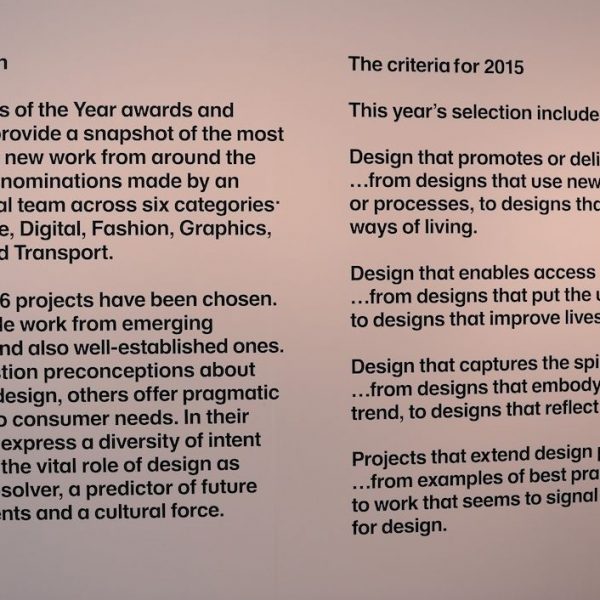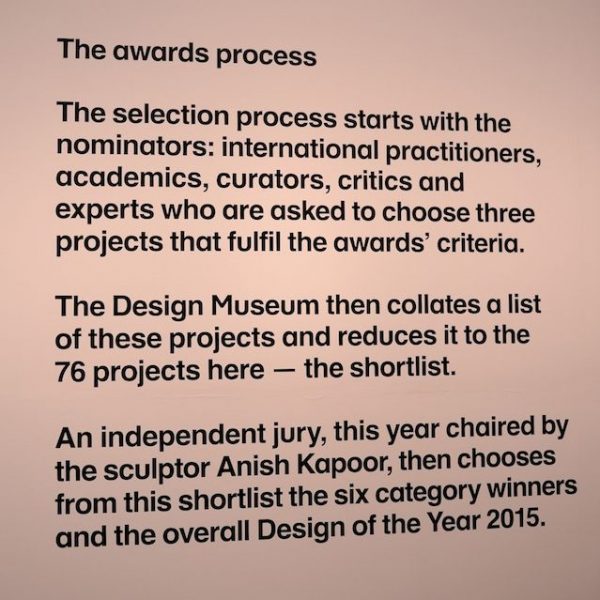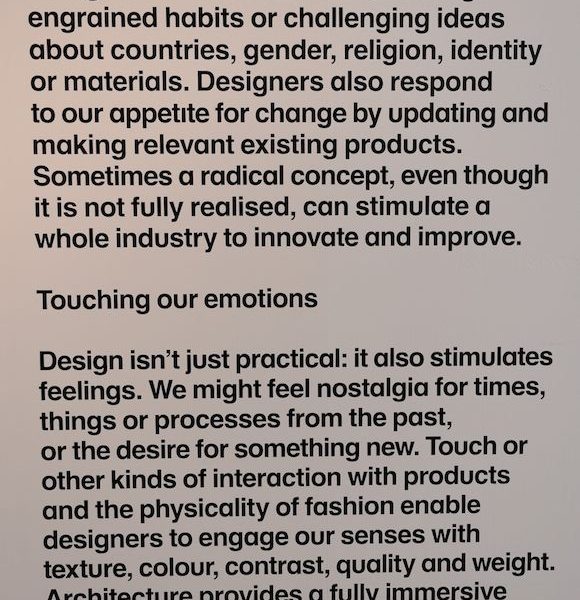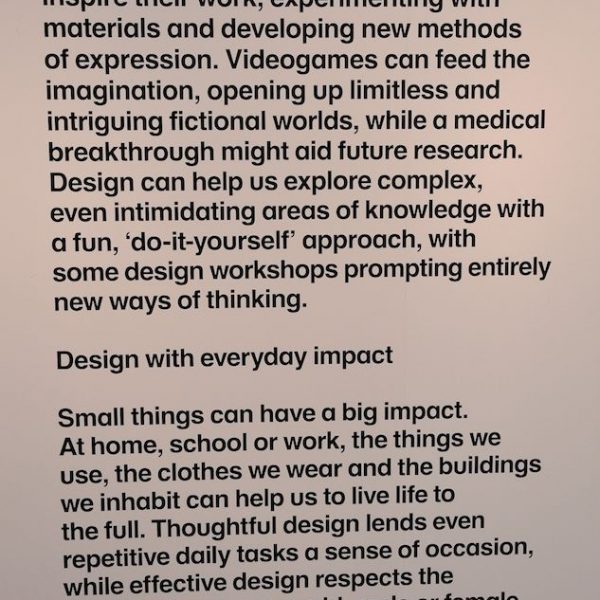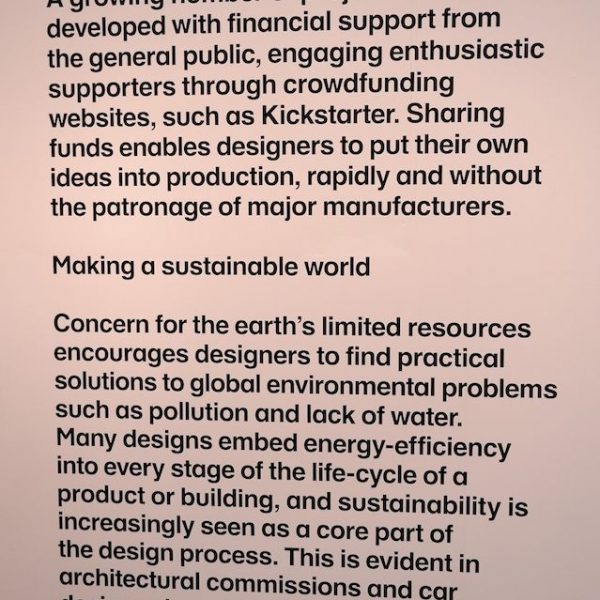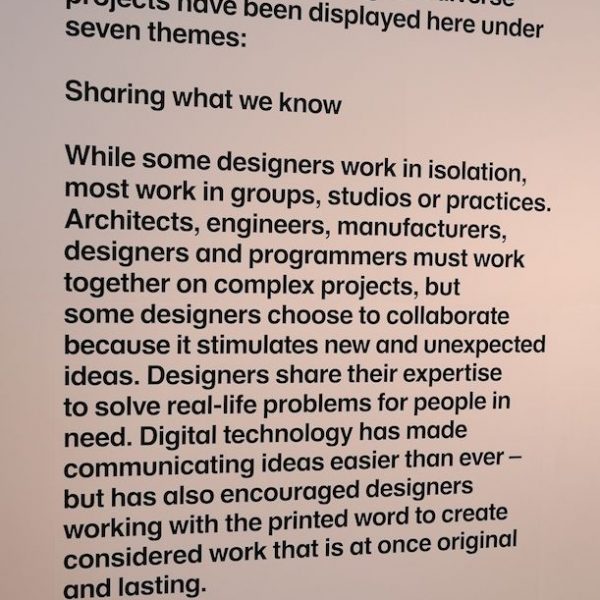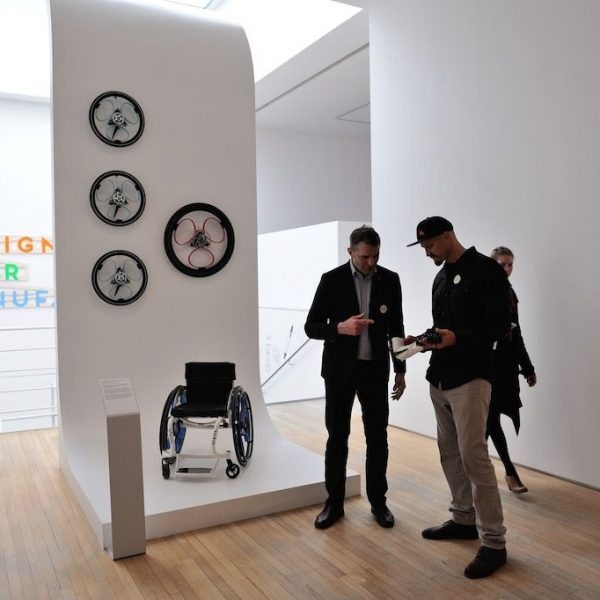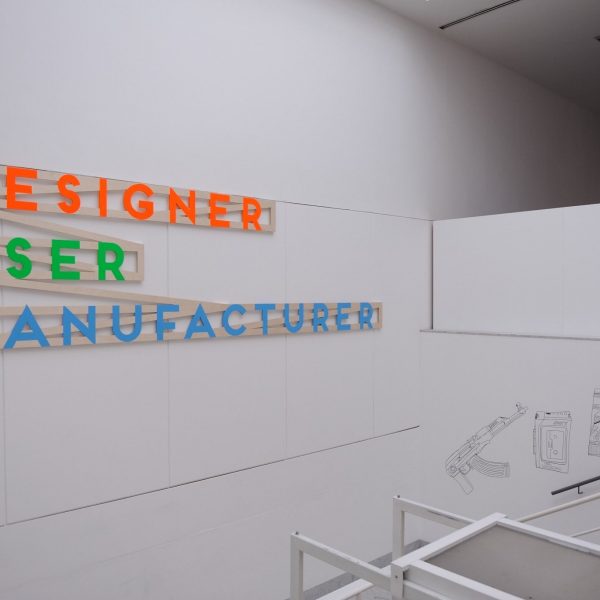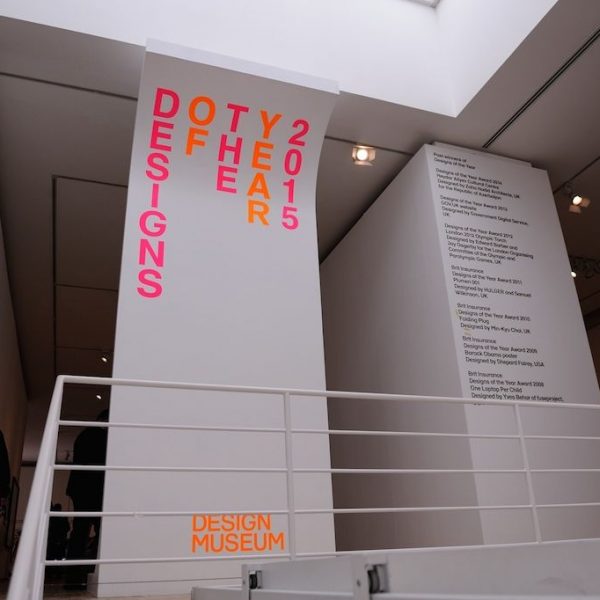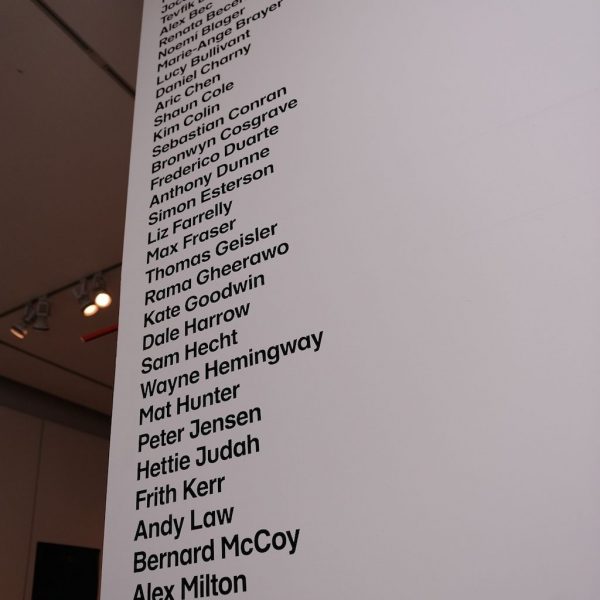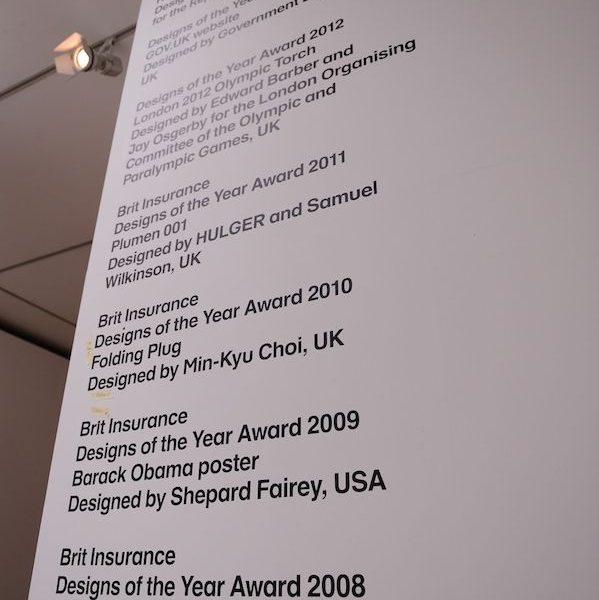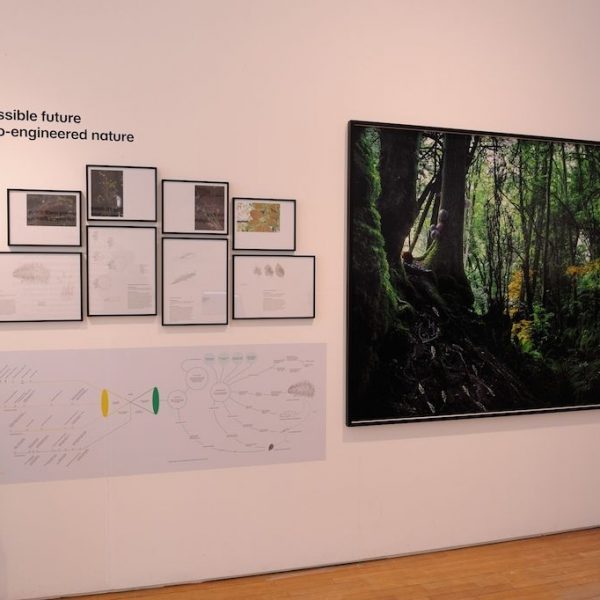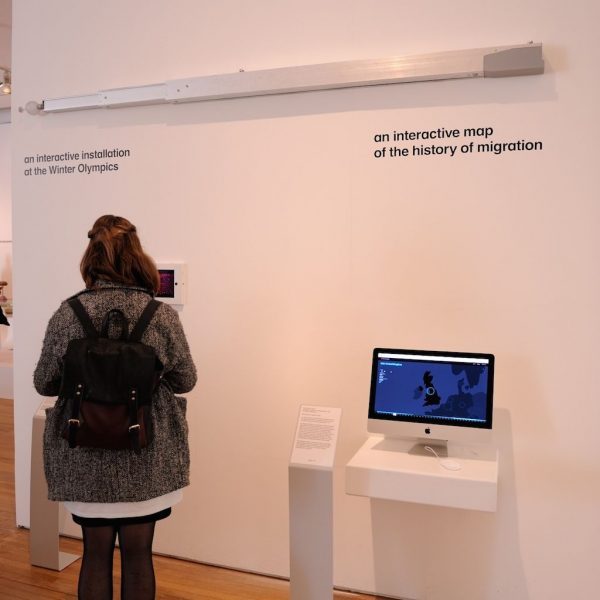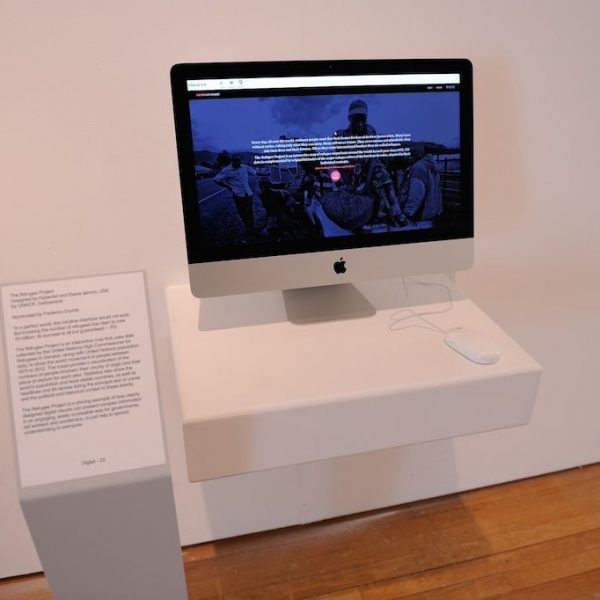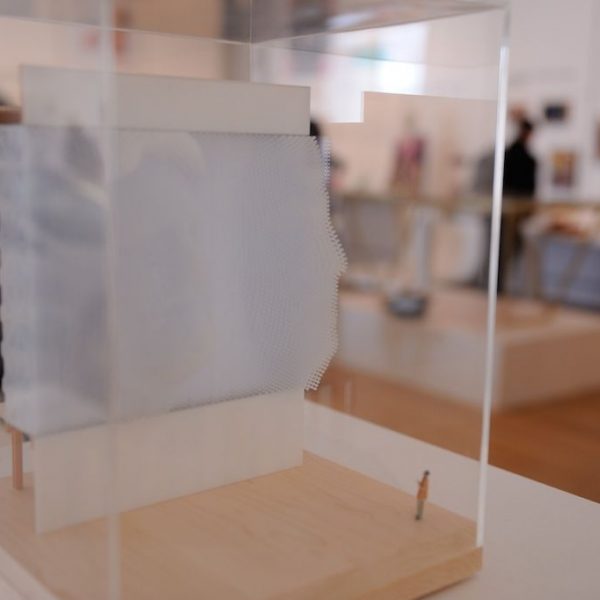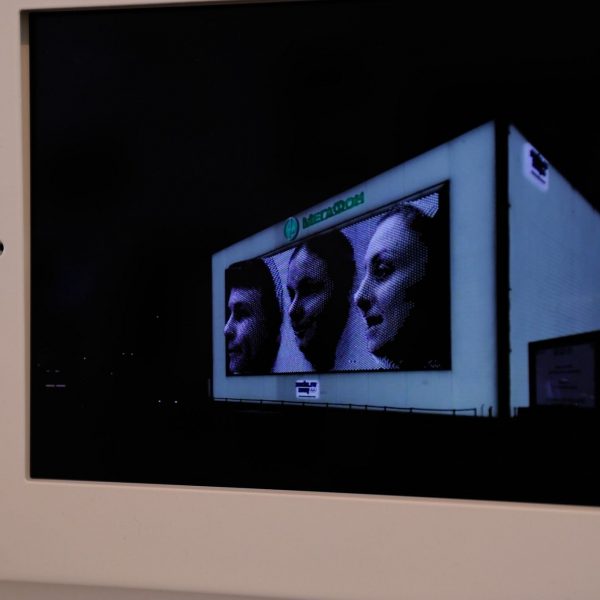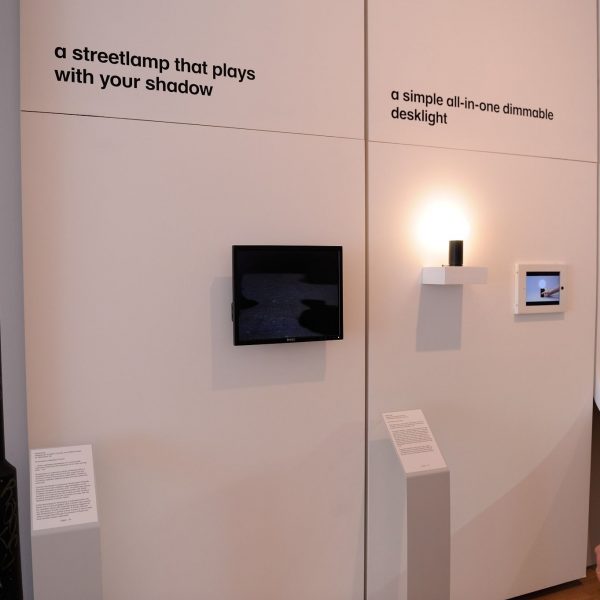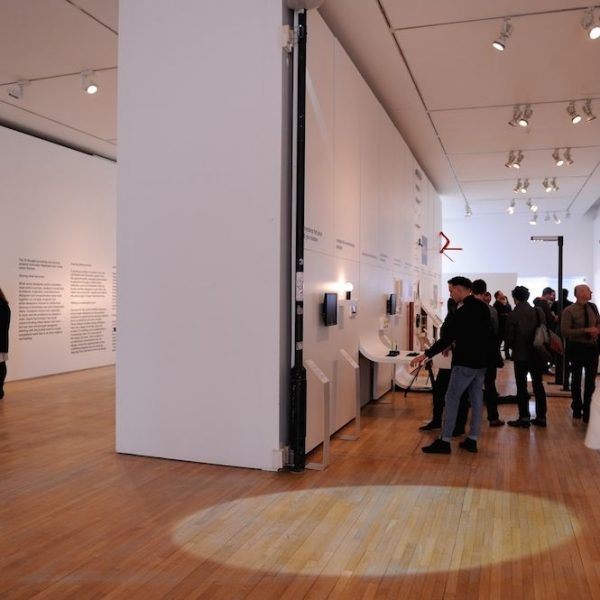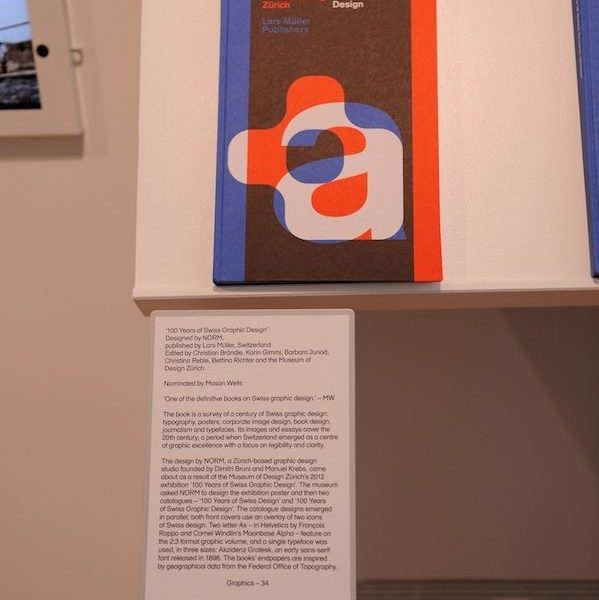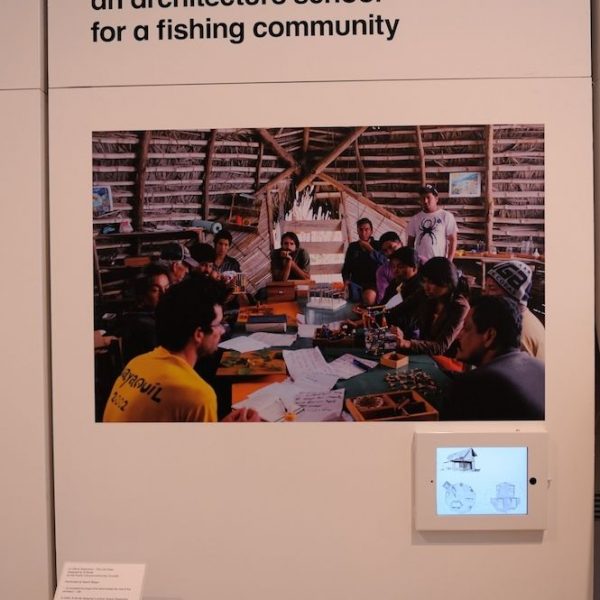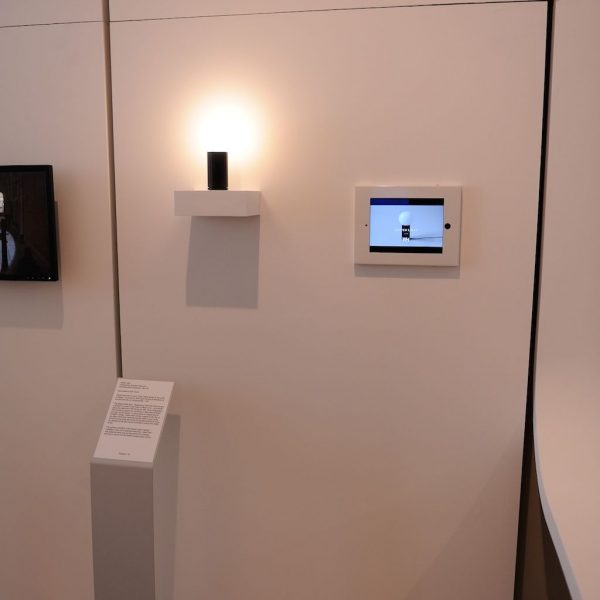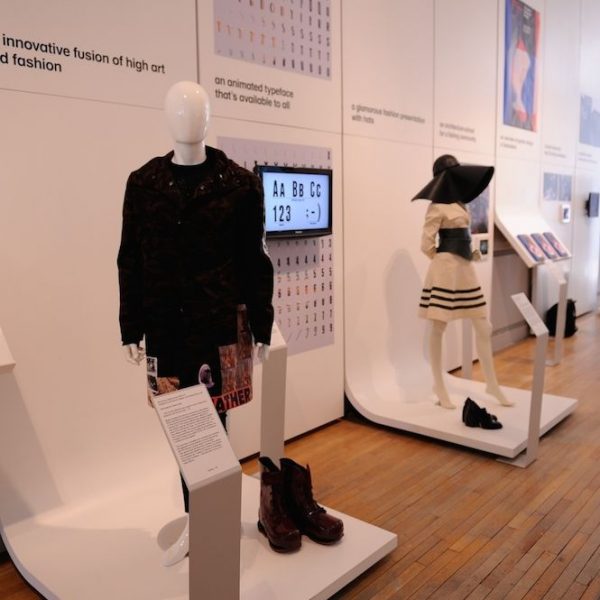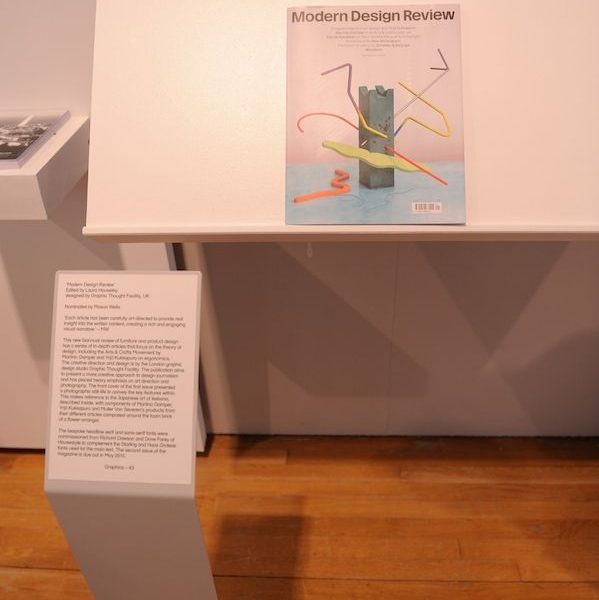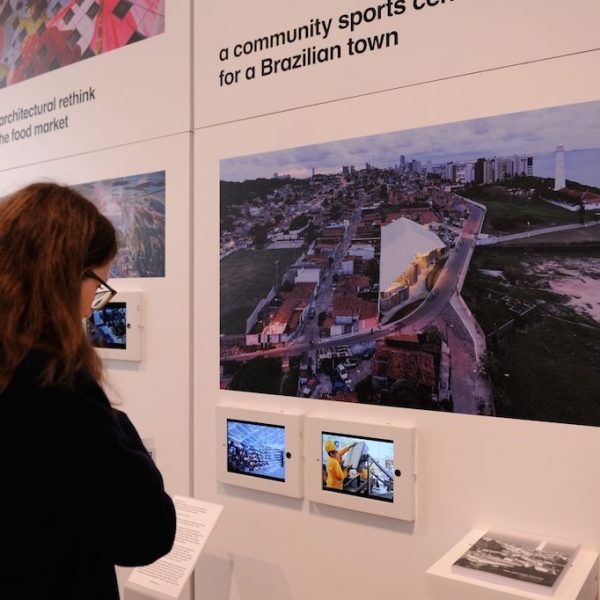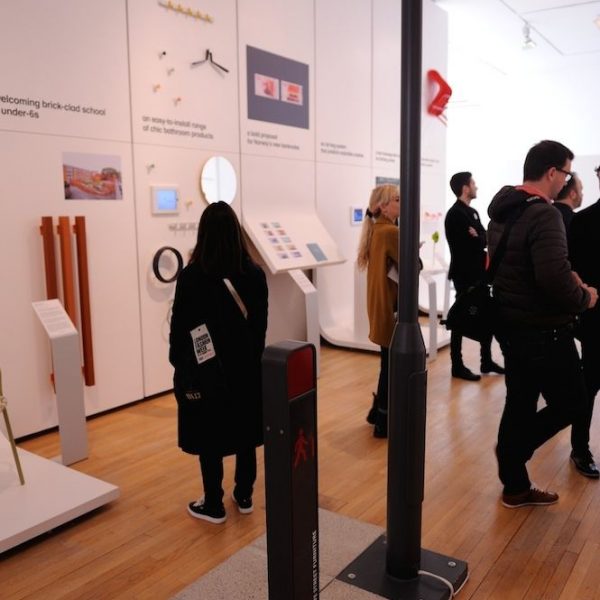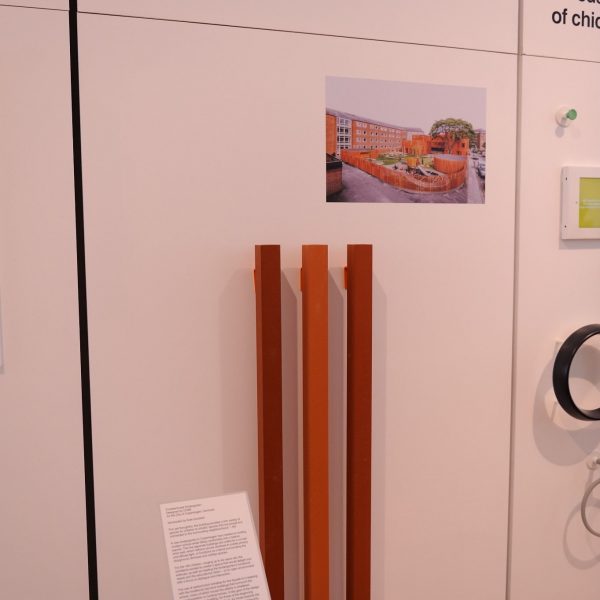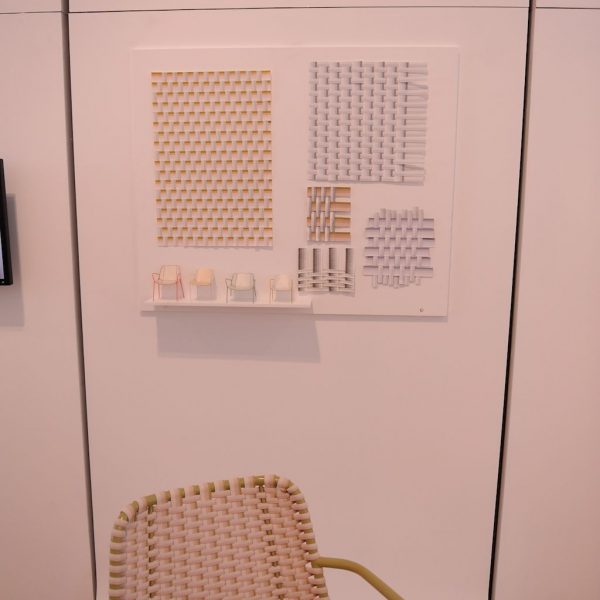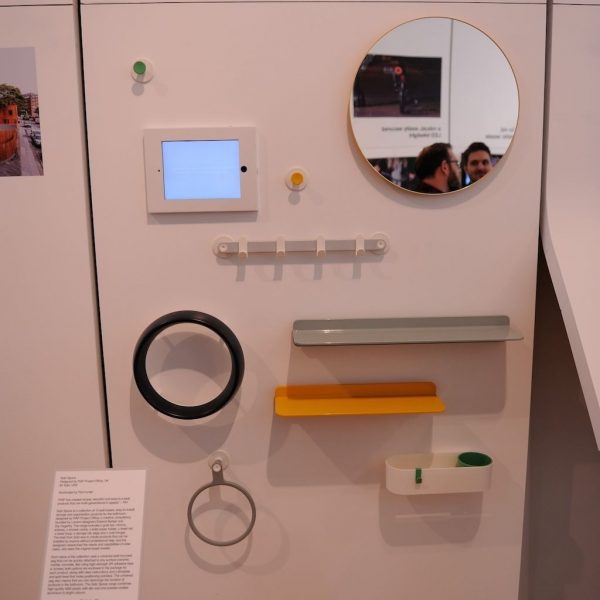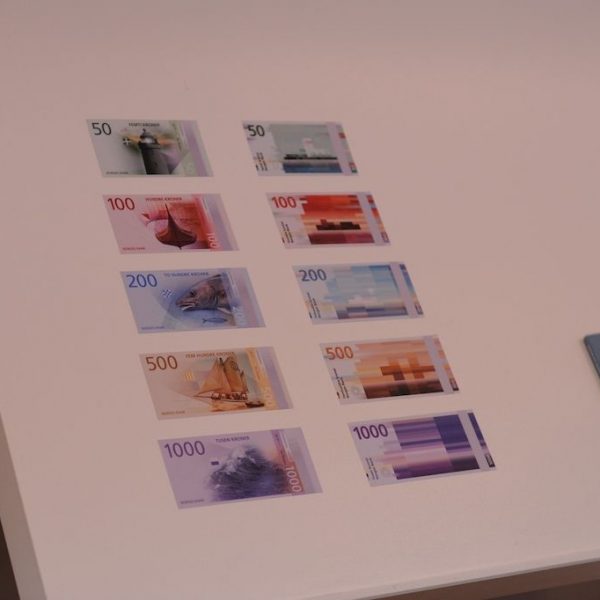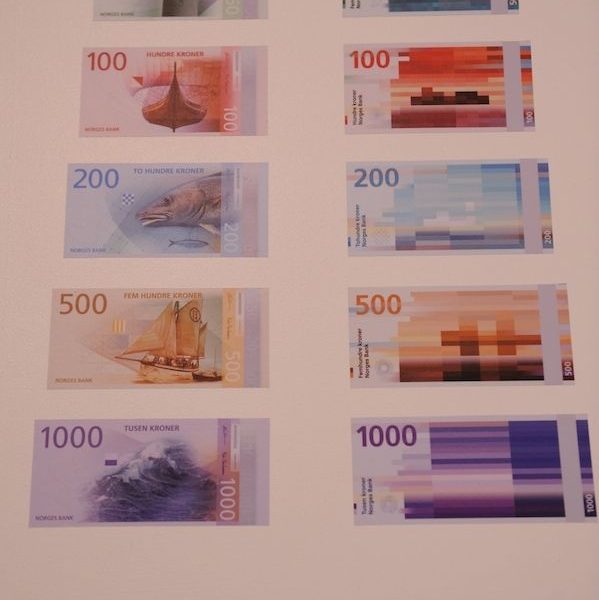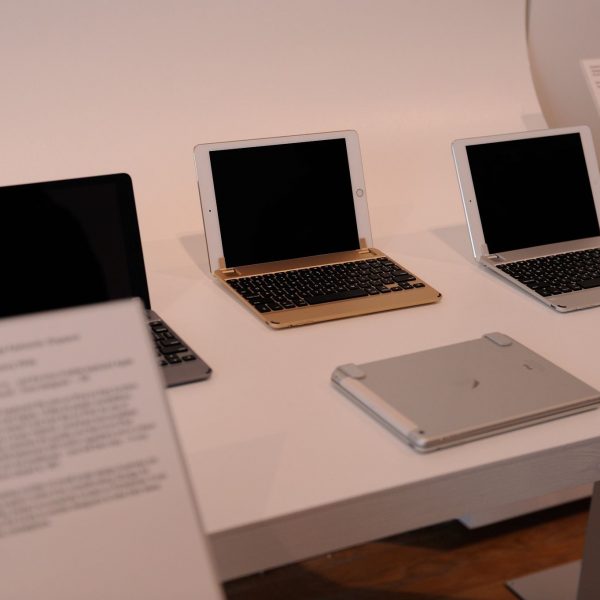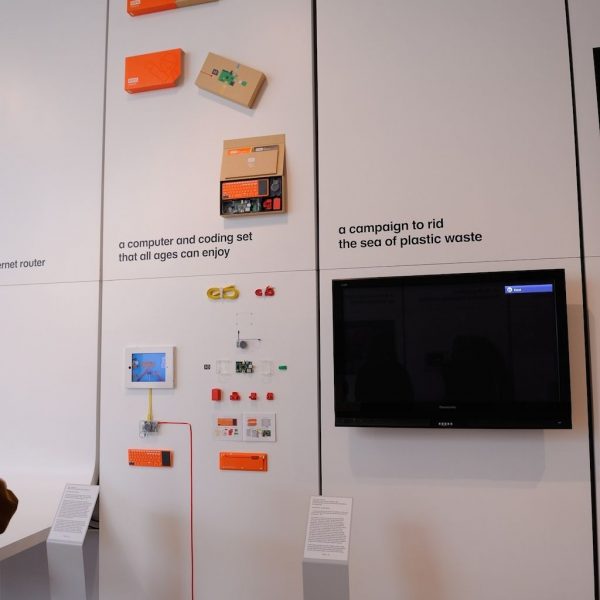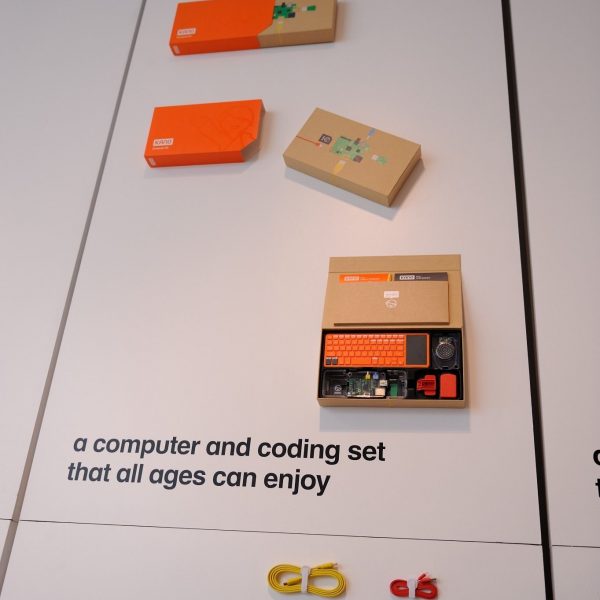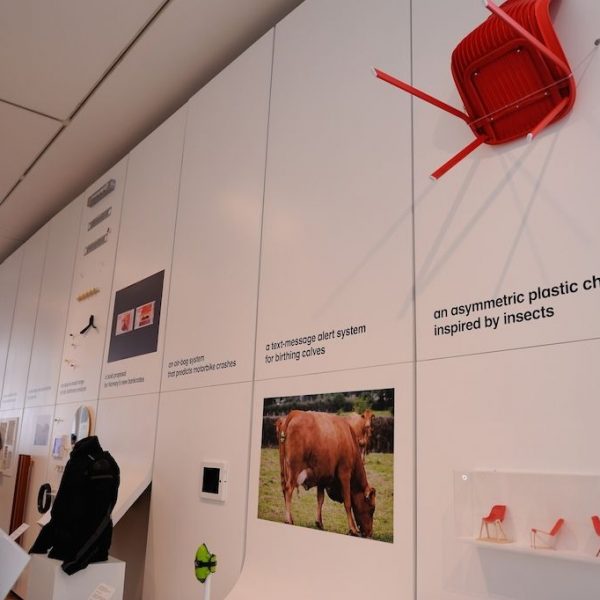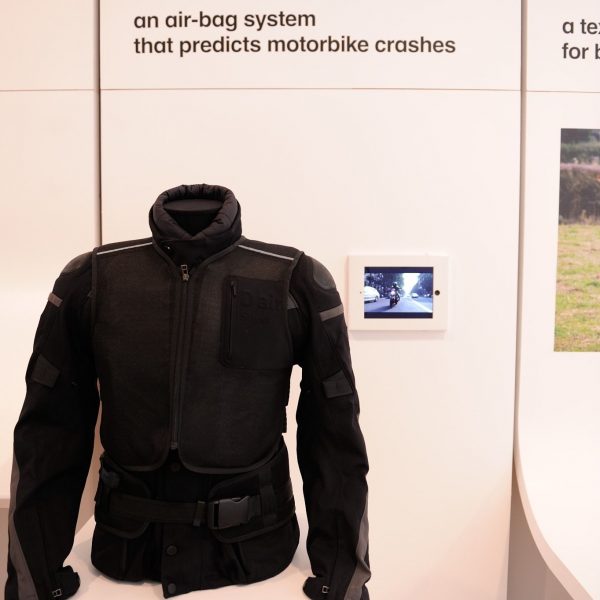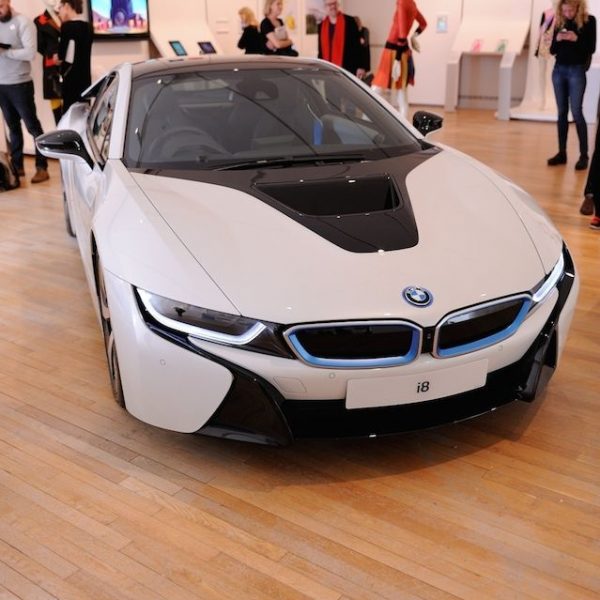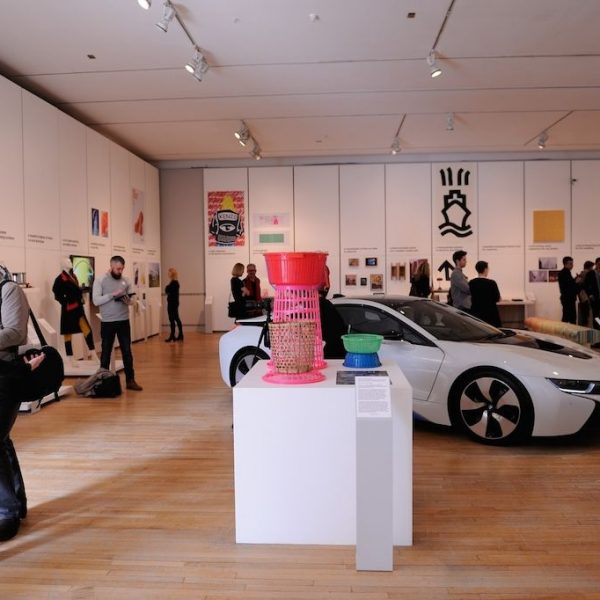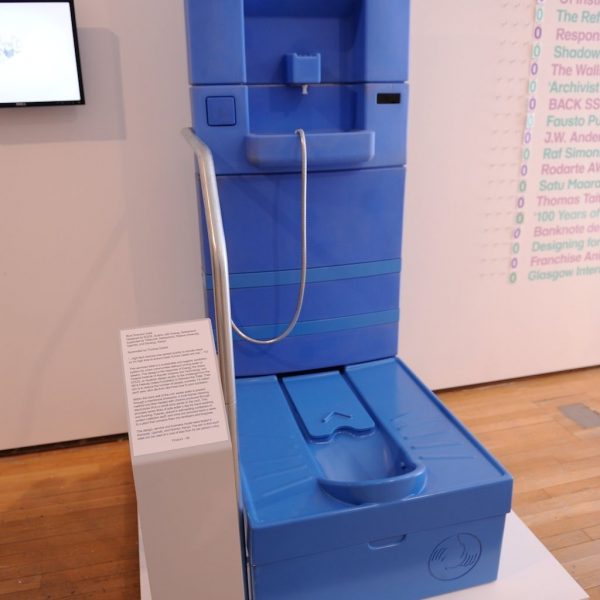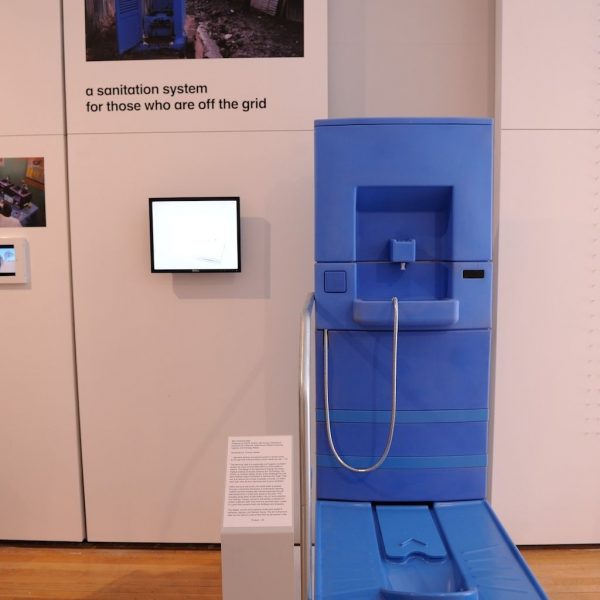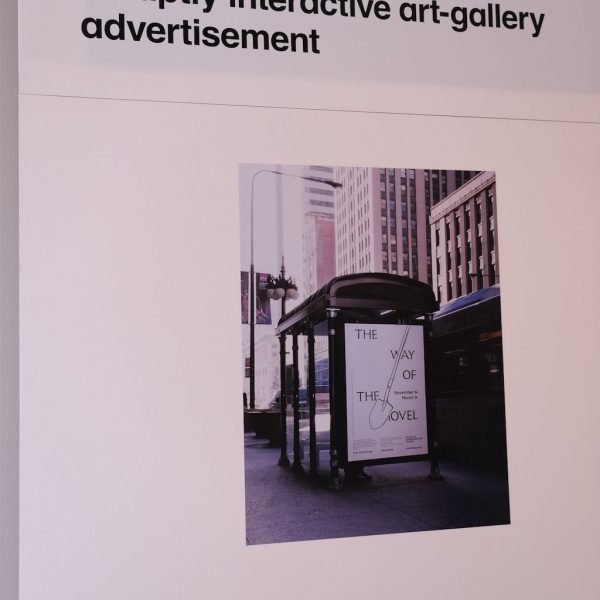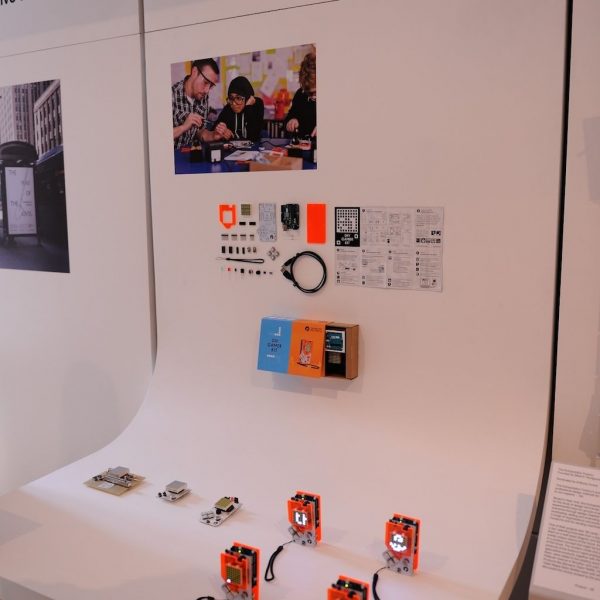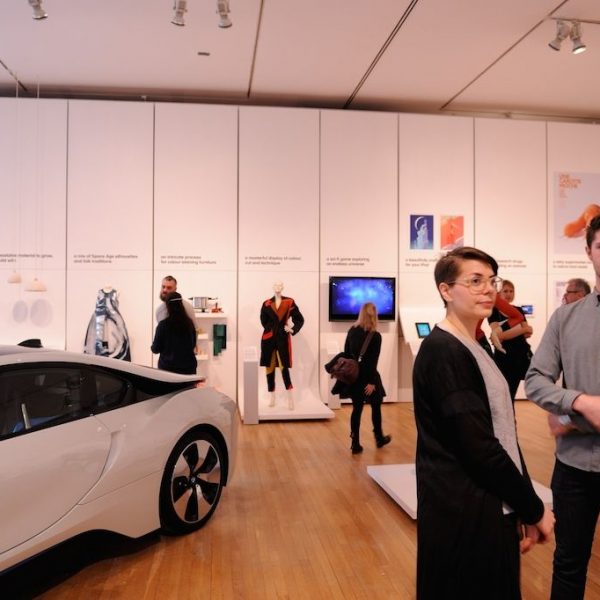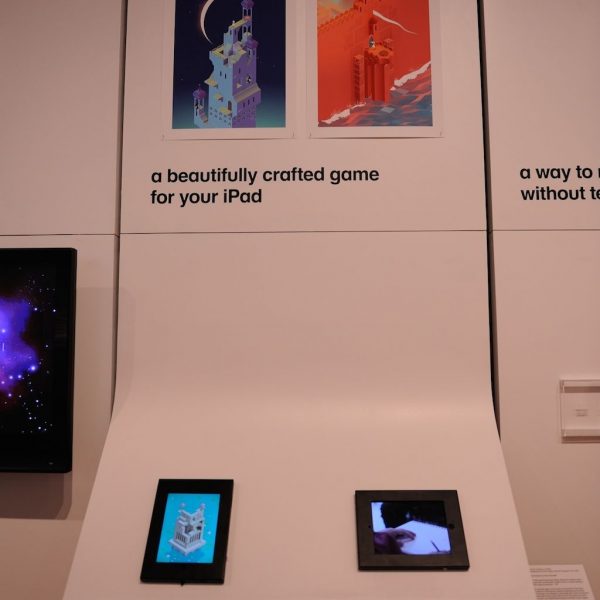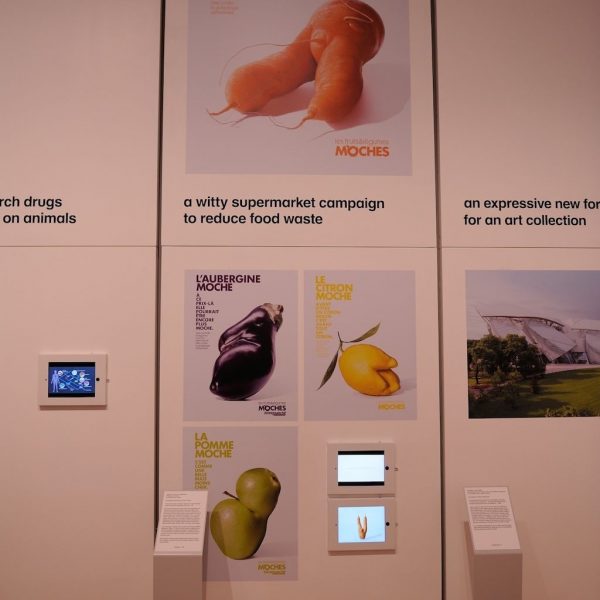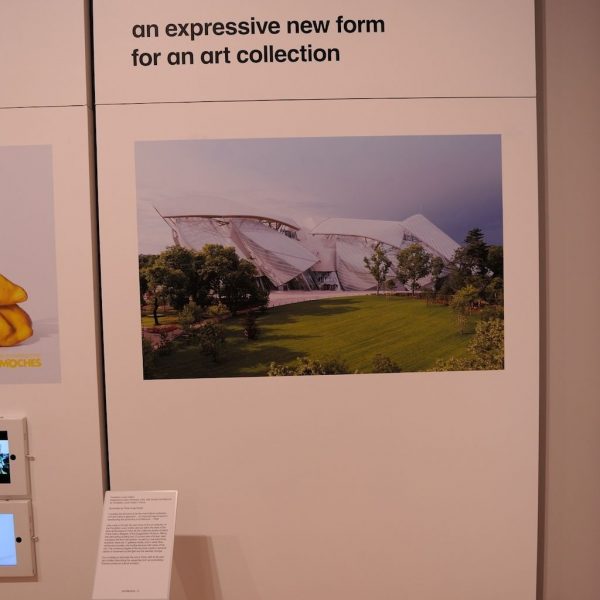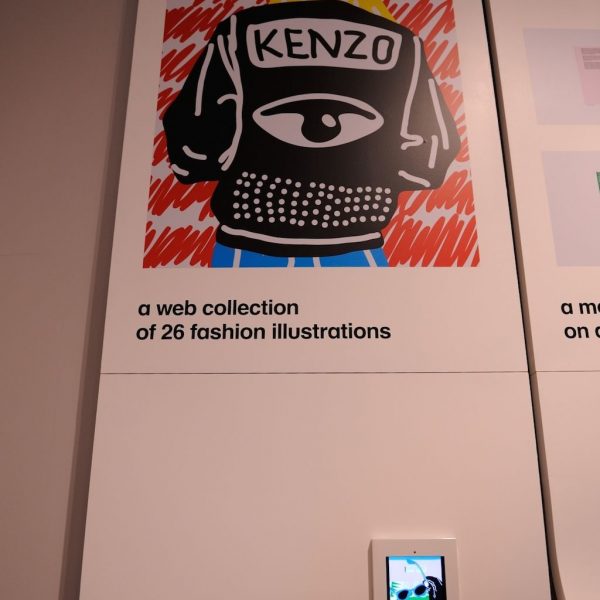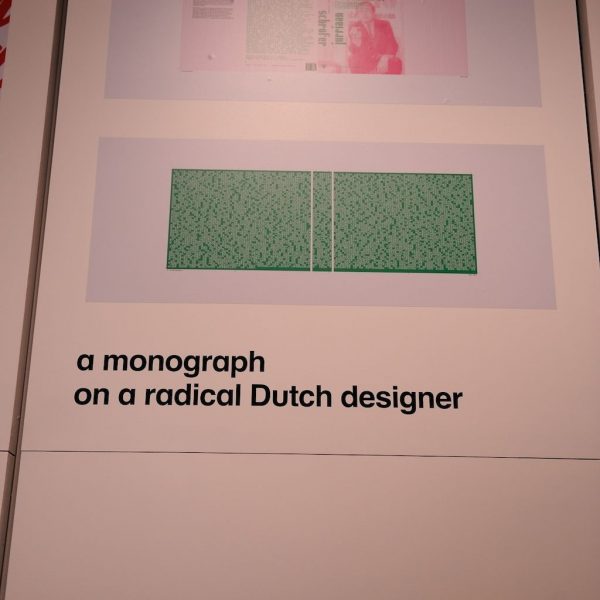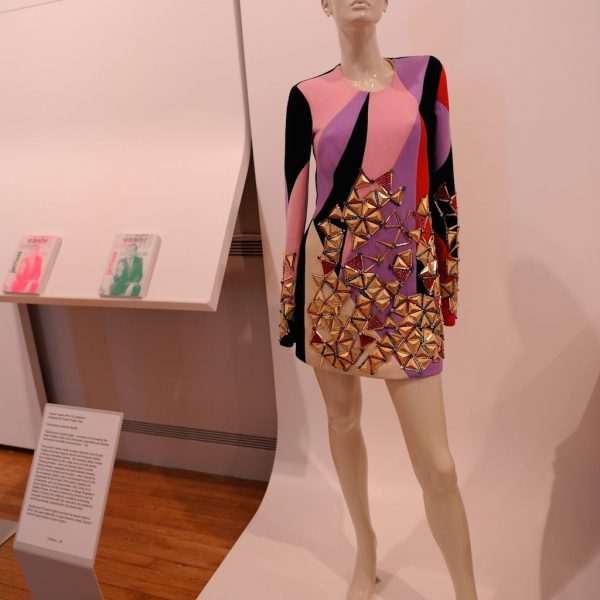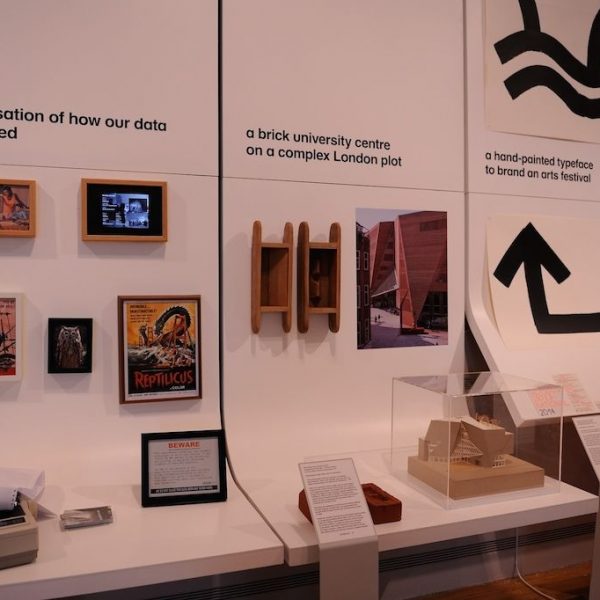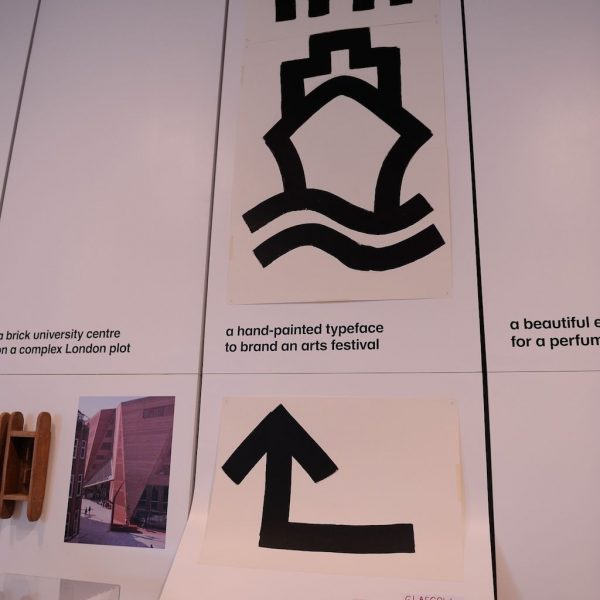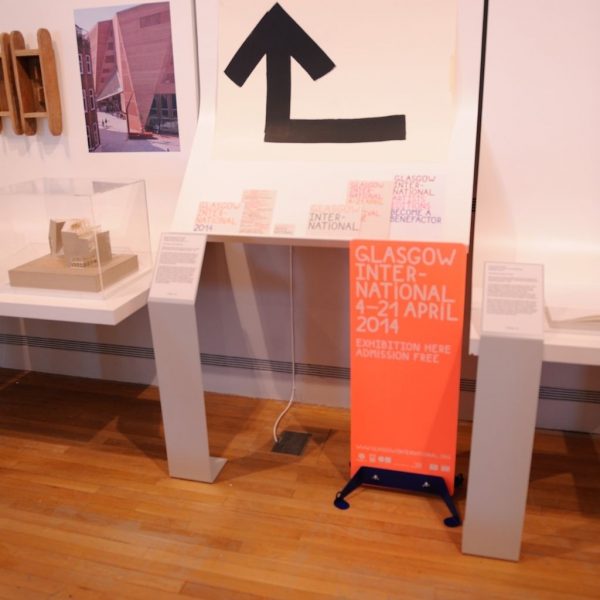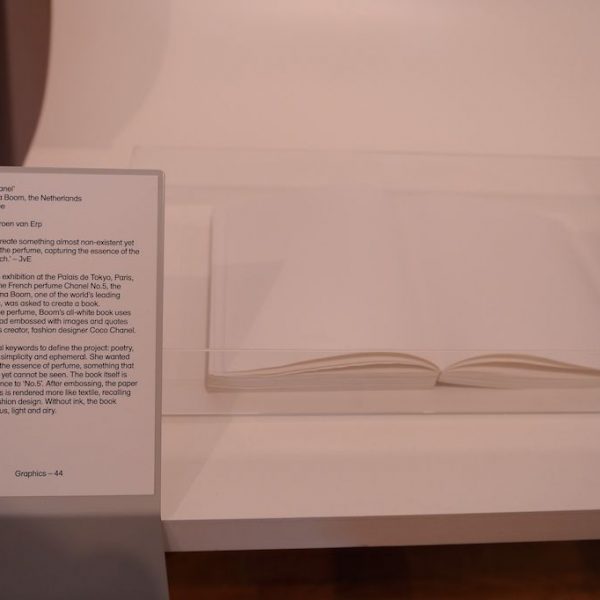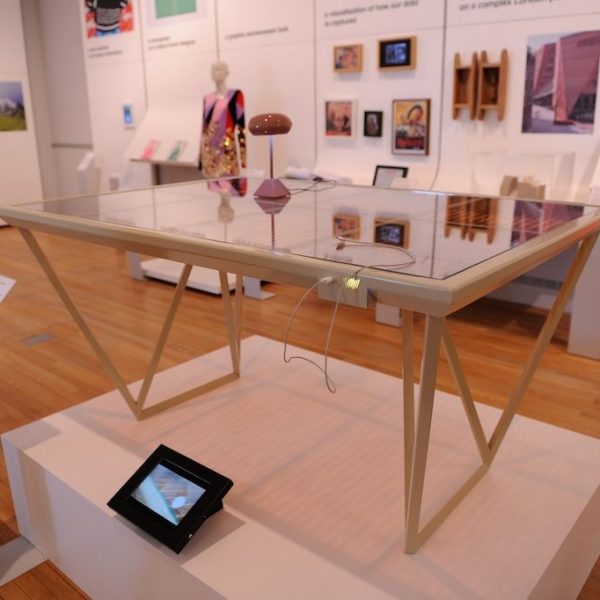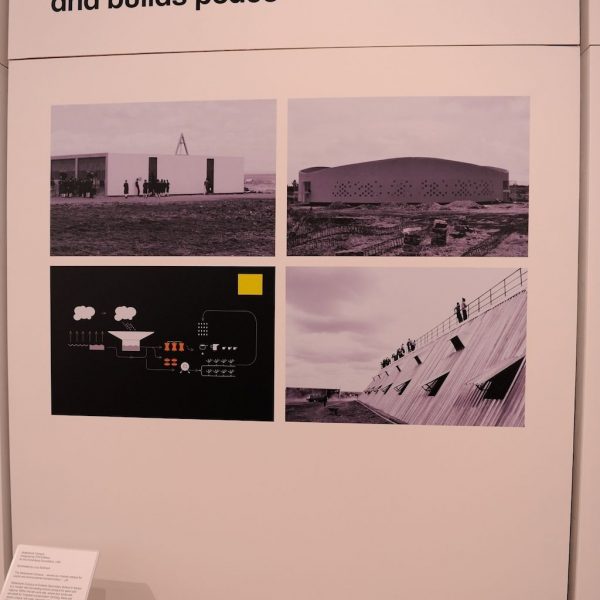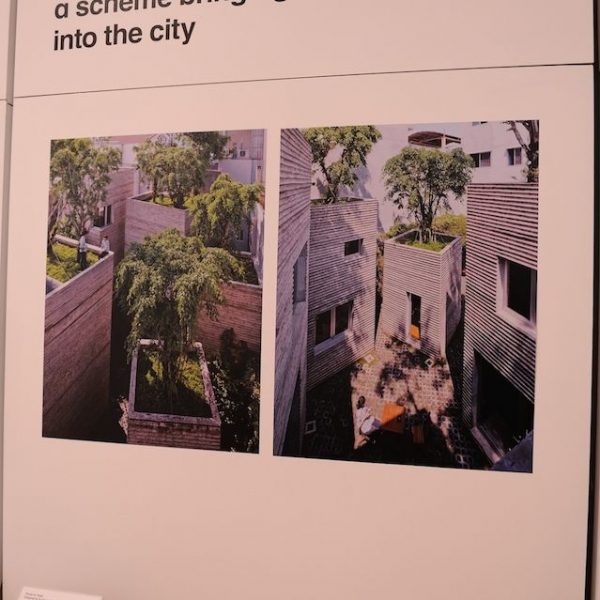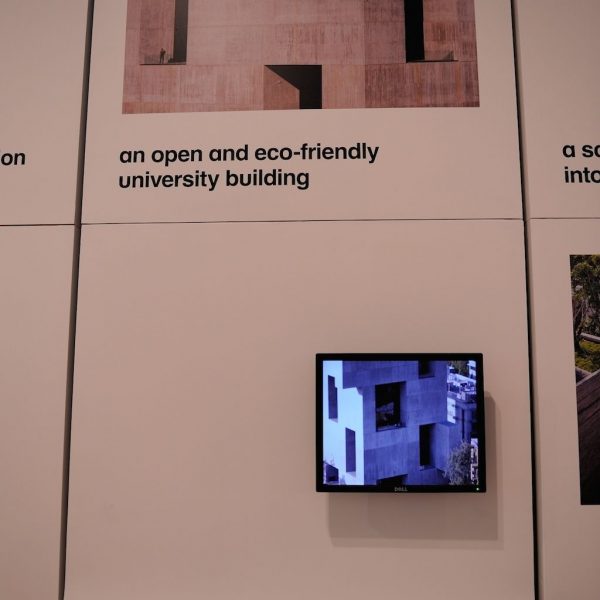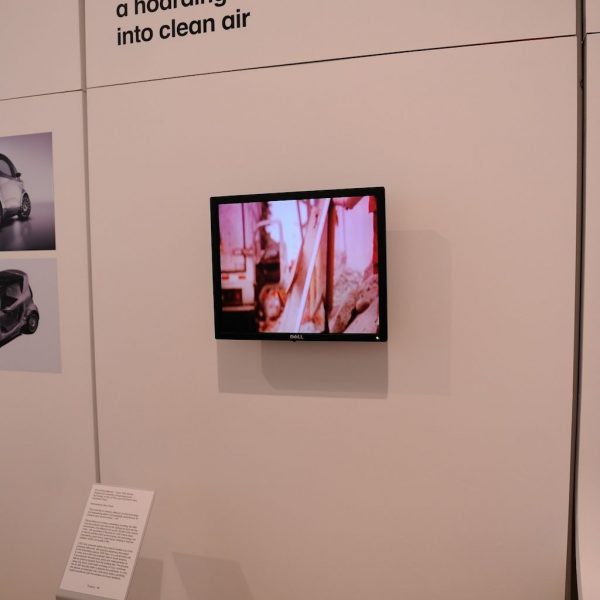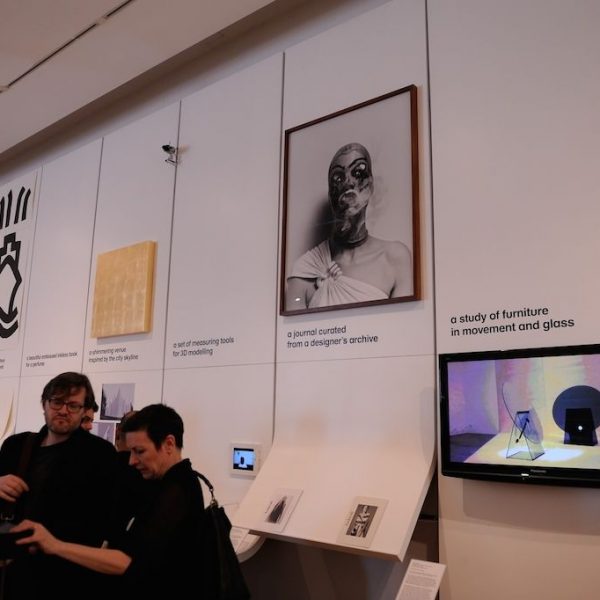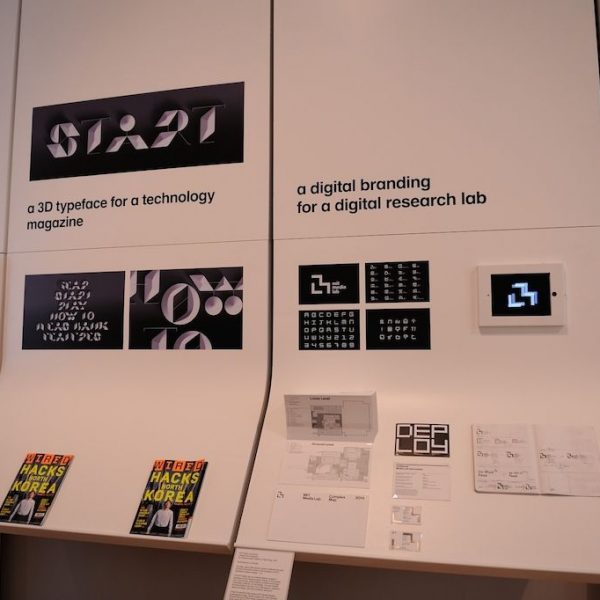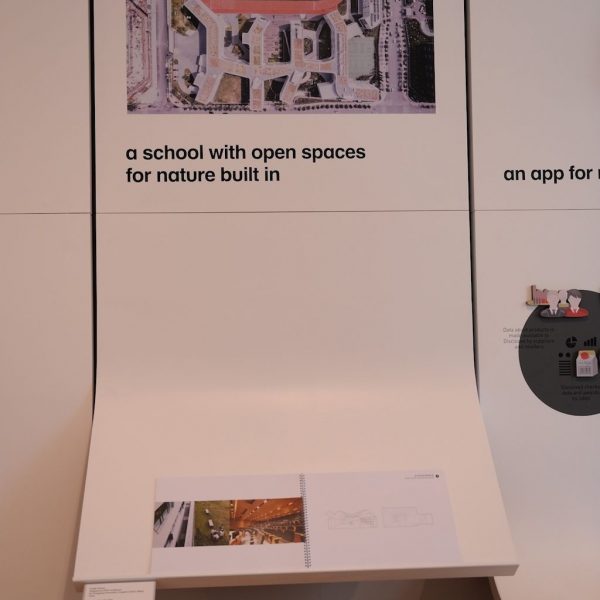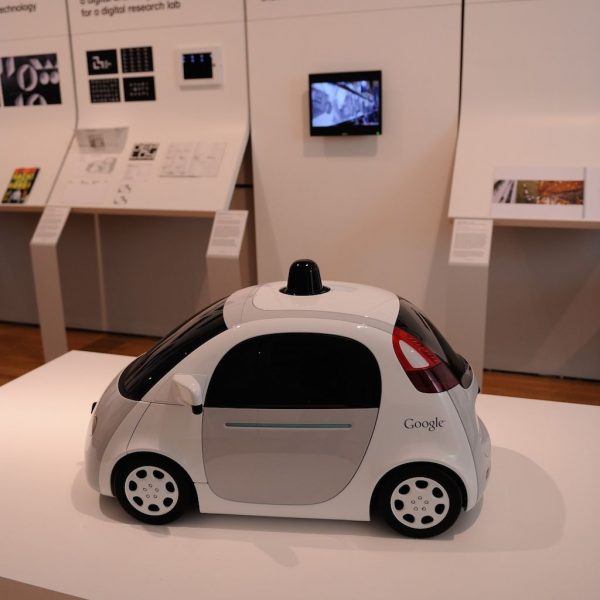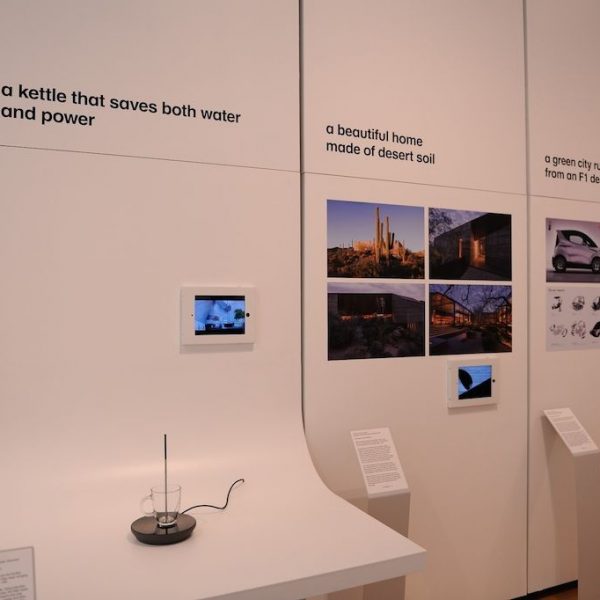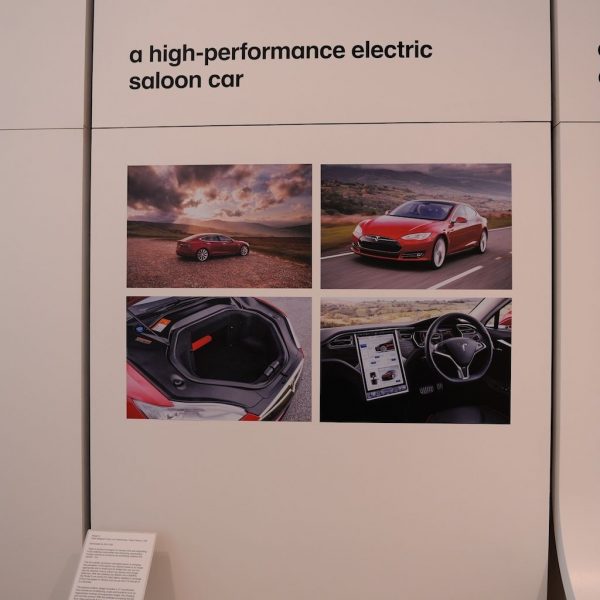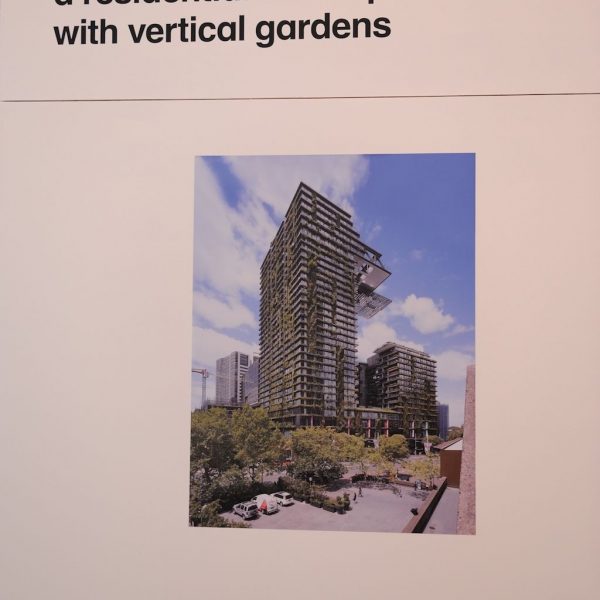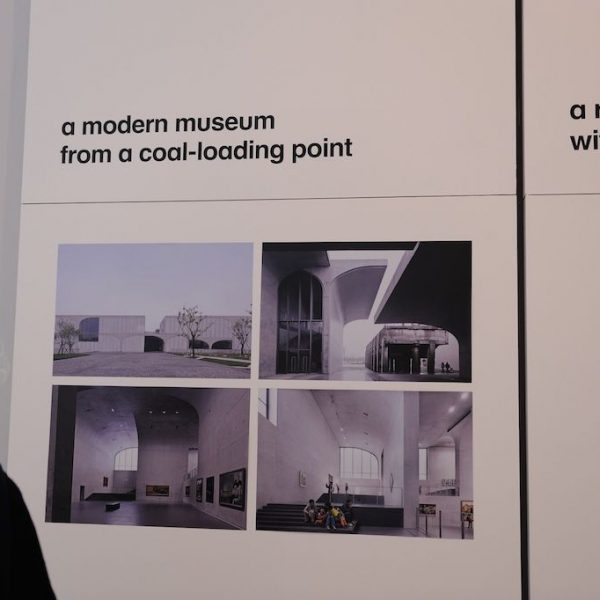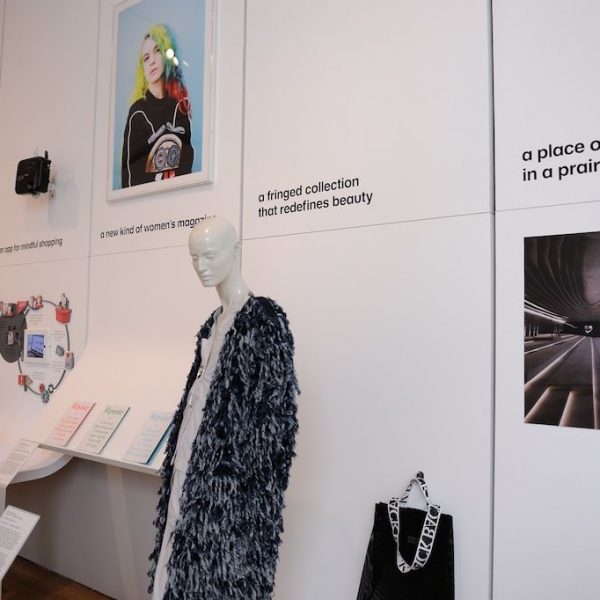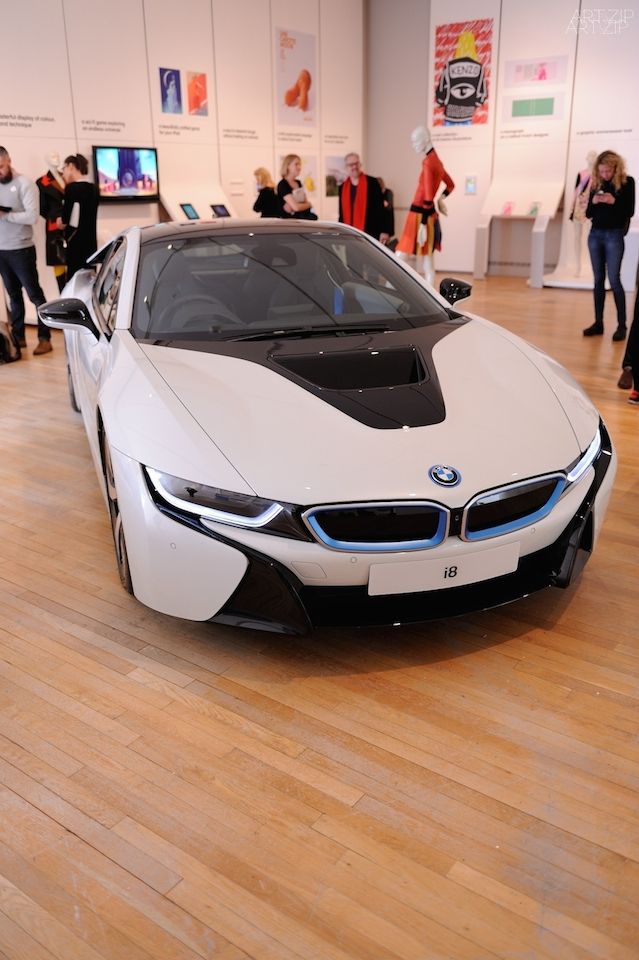
25 MARCH 2015 – 23 AUGUST 2015
London Design Museum
DESIGNS OF THE YEAR 2015: NOMINEES ANNOUNCED
76 NOMINATED PROJECTS INCLUDE AN OFF-GRID ECO TOILET, MICROCHIPS THAT MIMIC HUMAN ORGANS, A CAMPAIGN PROMOTING UGLY VEGETABLES AND A BOOK PRINTED WITHOUT INK
2015’s Designs of the Year nominees, announced today by London’s Design Museum, represent the global breadth of design talent, featuring some of the industry’s biggest names alongside rising stars and little-known practices. Google’s self-driving car, Frank Gehry’s Fondation Louis Vuitton and Asif Kahn’s Sochi Olympic Megafaces are just some of the high-profile projects to be represented in the exhibition of nominees which opens at the Design Museum on 25 March.
Now in its eighth year, Designs of the Year celebrates design that promotes or delivers change, enables access, extends design practice or captures the spirit of the year. The international awards and exhibition showcase projects from the previous year, across six categories: Architecture, Digital, Fashion, Product, Graphics, and Transport.
Design experts, practitioners and academics from across the world are asked by the Design Museum to suggest potential projects, from which the museum has selected 76 for nomination and display in the exhibition. A specially selected jury chooses a winner for each category and an overall winner.
Designs of the Year’s wide-ranging scope provides a snapshot of the contemporary concerns of the design world, with nominees coming from over thirty countries across five continents. A strong theme for 2015 is the desire to harness new technologies to solve long-standing problems, as seen in projects as diverse as the world’s first lab for 3D printing prosthetic limbs, and the Moocall sensor which is connected to a cow’s tail and texts the farmer when calving is imminent.
An interest in democratising design and empowering users can be seen across the board, notably in AL BORDE’s architectural school for an Ecuadorian fishing community, and Technology Will Save Us’s DIY Gamer Kit which encourages everyone to get coding.
Beauty combined with utility never goes out of style – Paul Cocksedge Studio’s Double O bike lights and Marjan Van Aubel’s phone charging Current Table are as pleasurable to look at as they are to use.
The 2015 Designs of the Year jury are:
Anish Kapoor, Artist (Chair)
Hilary Alexander, Writer and stylist
Alexis Georgacopoulos, Director of Ecole cantonale d’art de Lausanne
Farshid Moussavi, Architect and Professor at Harvard University Graduate School of Design
Richard Woolley, Studio Director, Land Rover Design Research & Special Vehicle Operations
The Designs of the Year category winners are announced on Monday 4 May, with the overall winner being revealed at an event at the Design Museum on Thursday 4 June.
Full list of nominees with descriptions below
THE DESIGNS OF THE YEAR 2015 NOMINEES:
ARCHITECTURE
ARENA DO MORRO
Natal, Brazil
Designed by Herzog & de Meuron
This gymnasium was created from an existing sports facility situated in Mãe Luiza, a favela in Natal, north-east Brazil. It now contains a sports field with tiered seating for 420 people, multipurpose rooms for dance and education, a terrace with ocean views, as well as changing rooms and public restrooms. The building’s standout feature is its generous roof, which is constructed to allow light and air in but keep water out, giving a new civic place visible from afar. The two ends of the elongated pitched roof open up towards the neighbourhood and invite people in.
BEIJING NO.4 HIGH SCHOOL FANGSHAN CAMPUS
Beijing, China
Designed by OPEN Architecture
Also called the Garden School, this building is part of a larger scheme to build a healthier and self-sustainable new town just outside Beijing. The desire to create more open spaces filled with nature, combined with the space limitations of the site, inspired a strategy on the vertical dimension, creating multiple grounds by separating the programs into above and below, and inserting gardens in-between. The roof-top of the upper building is designed to be an organic farm, with 36 plots – one for each class in the school, providing students the chance to learn the techniques of farming, and also paying tribute to the site’s pastoral past.
DESERT COURTYARD HOUSE
Scottsdale, Arizona, USA
Designed by Wendell Burnette Architects
A private house in Arizona’s Sonoran Desert which has been designed around a courtyard. The ancient construction method of rammed earth was used to create walls offering high thermal mass and a direct relationship to the surrounding landscape. By paying close attention to the desert location the architects have created a house which spirals up from lowest point at southwest corner and out towards a sunset view.
FORFATTERHUSET KINDERGARTEN
Copenhagen, Denmark
Designed by COBE
With its curved corners, lush roof gardens and special brick facade, the new kindergarten in Copenhagen creates a warm modern feeling while respecting its historic surroundings. The project consists of five small houses held together by a brick band which also surrounds the playground.
The Kindergarten is organized like a village, creating a place that is functional and flexible for adults, while also small and exciting for children.
FONDATION LOUIS VUITTON
Paris, France
Designed by Frank Gehry and Gehry Partners
The Fondation Louis Vuitton houses temporary displays, the permanent art collection and concerts in a ‘glass cloud’ of 12 curved sails that emerge from the Bois de Boulogne in Paris. The building’s distinctive shape has been made using over three thousand curved and fritted glass panels.
HOUSE FOR TREES
Ho Chi Minh City, Vietnam
Designed by Vo Trong Nghia Architects
Under rapid urbanization, cities in Vietnam have diverged far from their origins as sprawling tropical forests. An over-abundance of motorbikes causes daily traffic congestion as well as serious air pollution. House for Trees is an effort to change this situation. The aim is to bring green back into the city, accommodating high-density dwelling with big tropical trees. Five concrete boxes are designed as ‘pots’ to plant trees on their tops. With thick soil layer, these pots also function as storm-water basins for retention, therefore contribute to reduce the risk of flooding when the idea is multiplied to a large number of houses in the future.
LA ÚLTIMA ESPERANZA – THE LAST HOPE
Manabi, Ecuador
Designed by AL BORDE
La Última Esperanza is the final iteration of a long-term collaboration between AL BORDE and the Cabuyal community which has already produced a school and a community centre. This project saw the architects design not a building, but system for teaching architecture so that the community can become more self-sufficient, developing their own methodology of design, and ultimately creating their own buildings.
LONG MUSEUM WEST BUND
Shanghai, China
Designed by Atelier Deshaus
Long Museum West Bund is located at the bank of Huangpu River, Xuhui District, Shanghai Municipality, on a site which had been used as the wharf for coal transportation. The design of the new museum adopts a cantilever structure featuring an umbrella vault which visually echoes a remaining coal hopper unloading bridge – a symbol of the area’s industrial past.
MARKTHAL ROTTERDAM
Rotterdam, the Netherlands
Designed by MVRDV
Located in the center of Rotterdam, Markthal is the first covered food market of the Netherlands. Each of the 228 apartments has a view either towards the historic Laurenskwartier, and towards the market through windows or a glass floor made of sound and smell proof triple glazing. The open sides of the Markthal closed to prevent rain and cold from entering, was designed to be as transparent as possible by opting for a single glazed cable net façade. The mural ‘Cornucopia’ by artists Arno Coenen and Iris Roskam has a surface of 11.000 m². ‘Cornucopia’ shows oversized images of market produce available at the market, while the flowers and insects refer to the work of Dutch still life masters from the 17th century. The image was printed onto perforated aluminum panels, and then attached to acoustic panels for noise control.
ONE CENTRAL PARK
Sydney, Australia
Designed by Ateliers Jean Nouvel
Two landmark towers designed by Jean Nouvel for the second phase of the One Central Park project have transformed Sydney’s skyline. The program comprises an exclusively residential apartment block of 34 stories and a 12-story apartment block that sits on a common retail and recreational podium. A vertical landscaped garden designed in collaboration with French artist and botanist Patrick Blanc covers approximately 50% of the buildings’ façade.
PHILHARMONIC HALL SZCZECIN
Szczecin, Poland
Designed by Barozzi / Veiga
The new Philharmonic Hall of Szczecin is located on the historical site of the ‘Konzerthaus’, which was destroyed during Second World War and recomposes an urban corner in a neighbourhood near to the historic city. The building houses a symphony hall for 1000 spectators, a hall for chamber music, a multifunctional space for exhibitions and conferences, and a wide foyer, which can also be used to host events. The hall is composed following a Fibonacci sequence whose fragmentation increases with the distance from the scene, and gives shape to an ornamental space whose gold-leaf covering calls to mind the classical tradition.
SANCAKLAR MOSQUE
Istanbul, Turkey
Designed by Emre Arolat Architects
Inspired by the fact that a mosque does not have a predefined form and anywhere clean may be a prayer room, this project focused on the ‘essence’ of a religious space, distancing itself from discussions based on form. The design aimed at representing purest forms of light and matter, just as a primary inner world, free from all cultural burdens. The disappearance of the building in to the slope of the site, anchored to the ground, creates the sense that it has always been a part of this landscape.
SAW SWEE HOCK STUDENT CENTRE, LONDON SCHOOL OF ECONOMICS
London, UK
Designed by O’Donnell + Tuomey
The site specific sculptural concept for this design is tailored in response to specific lines of sight along approaching vistas, from street corner perspectives and to make visual connections between internal and external circulation. The surface of the brick skin is cut out along fold lines to form large areas of glazing, framing views from street to room. The design is assembled to make one coherent volume from a complex set of component parts. The building is clad with bricks, used in a new way, with each brick offset from the next in an open work pattern, wrapping the walls in a permeable blanket, creating dappled daylight inside and glowing like a lattice lantern at night.
UC INNOVATION CENTER – ANACLETO ANGELINI
Santiago, Chile
Designed by ELEMENTAL
Santiago’s weather inspired the architects to substitute the contemporary typical glass skin, responsible for serious greenhouse effect in interiors, for a thermal mass on the perimeter that avoids undesired heat gains. Open air squares are multiplied throughout the building’s entire height and a
permeable atrium core is proposed so that while circulating vertically, people could see what others are doing. As well as creating the right
environment for knowledge-creation, this design has reduced energy costs by two-thirds.
WATERBANK CAMPUS AT ENDANA SECONDARY SCHOOL
Laikipia, Kenya
Designed by PITCHAfrica
A ‘model’ rain harvesting school campus for semi-arid regions, the aim of this project is to support education with specially designed buildings that integrate water collection, storage and filtration with agriculture, using football as a catalyst, providing a gathering place and vehicle for environmental education and the resolution of ethnic tensions across the region. The ‘Waterbank Campus’ occupies a 10 acre site integrating 4 acres of irrigated conservation agriculture with 7 unique, low-cost, rain harvesting building types developed by PITCHAfrica, and termed ‘Waterbanks’ because of each building’s capacity to harvest and store high volumes of water using extremely low cost construction and locally available skills and materials, providing a year round supply for poverty stricken regions.
DIGITAL
DISCLOSED
Designed by Marion Ferrec at the Royal College of Art, in collaboration with Kate Wakely
Disclosed is a service concept which offers a transparency certification and data ecosystem – the aim being to help shoppers make more informed choices about the products they purchase. Through simple and tailored digital layers of information, users can act on what they individually believe matters for their health and the planet. Disclosed helps users gain more control over their consumption and channel their spending into products that best meet their ambitions, ultimately influencing retailers to invest in lines that better reflect those.
MEGAFACES
Designed by Asif Khan
Megafaces, which debuted at the Sochi Olympics, is an experimental architectural installation. It comprises a large scale kinetic-volumetric LED display supported by a bank of automated 3d-scanning photo booths, an automated 3d scan meshing system, a tablet app which uses QR-code cards, an SMS notification system, an automated 3d modelling and lighting algorithm, a web portal, and a video streaming service. The installation was commissioned by MegaFon. Described by the designer as ‘A Mount Rushmore for the digital age’, Megafaces is a building which could physically transform to take on the appearance of the people visiting it.
MONUMENT VALLEY
Designed by ustwogames
Inspired by the art of M.C. Escher, Japanese prints and minimalist 3D design, Monument Valley is a surreal exploration through fantastical architecture and impossible geometry. Players of this mobile game must guide the silent Princess Ida through mysterious monuments, uncovering hidden paths, taking advantage of optical illusions and outsmarting the enigmatic Crow People. Each level is a hand-crafted combination of puzzle, graphic design and architecture.
NO MAN’S SKY
Designed by Sean Murray
No Man’s Sky is a science-fiction-based videogame about exploration and survival in an infinite procedurally generated galaxy. The aim is to ensure that players experience the sense of wonder captured by classic science-fiction stories – and to ensure that there are things in the galaxy of 18,446,744,073,709,551,616 planets that not even the developers are aware of. This scope is made possible by a unique engine, developed in-house. Using procedural generation, the engine uses the computational power of next-generation consoles and PCs to generate terrain as the player explores.
OF INSTRUMENTS AND ARCHETYPES
Designed by Claire Warnier + Dries Verbruggen, Unfold (concept, design & hardware), Penny Webb (design & prototyping), Jesse Kirschner (concept & software)
Of Instruments and Archetypes is a range of wireless digital measuring instruments that transfer in realtime, measurements of physical objects to an on-screen digital 3D model. These instruments are designed to be used in applications where archetypical, parametric objects can be customised with exact measurements and materialised by digital production techniques such as 3D printing.
RESPONSIVE STREET FURNITURE
Designed by Ross Atkin (Conceptual design and digital system development), Jonathan Scott (Physical design and engineering)
Responsive Street Furniture uses smart technology to make streets easier to use for disabled people with different kinds of impairments, including reduced mobility, low vision, blindness and learning difficulties. The system consists of a website where users can register their smartphone, or a low-cost key fob, then request helpful services such as additional places to sit, brighter street lighting, longer crossing times or audio information, which are activated when users approach a responsive item. The system could also be used for tourists and foreign visitors – providing audio information in native and foreign languages.
SHADOWING
Designed by Jonathan Chomko, Matthew Rosier
Shadowing is an interactive installation embedded within streetlights throughout Bristol. It creates pockets of memory in the street; capturing the shadow of a pedestrian as they pass underneath the streetlight and then projecting it back to accompany the next person who passes by. Shadowing was first commissioned by Watershed as the winner of the 2014 Playable City Award and was installed in eight locations across Bristol during September and October 2014.
THE OCEAN CLEANUP
Designed by Boyan Slat (CEO and founder), Jan de Sonneville PhD (Lead engineer), Erwin Zwart (Designer)
Calling itself ‘the largest clean up in history’, this project aims to develop environmentally friendly, large-scale, and efficient removal of plastic pollution from aquatic ecosystems. Founded by Dutch environmentalist Boyan Slat after he encountered more plastic bags than fish while diving in Greece at the age of 16, the proposal takes the form of a network of floating barriers which cause natural currents to push plastics towards a central platform, allowing for efficient extraction and storage of concentrated plastic for transportation to land. The Ocean Cleanup recently raised over US$2 million through a crowd funding campaign, which the organisation plans to use for the construction and testing of large-scale operational pilots.
THE REFUGEE PROJECT
Designed by Hyperakt and Ekene Ijeoma
The Refugee Project is an interactive map that uses UNHCR refugee data and UN population data to tell the histories of refugee movements over time from 1975 to 2012. The map visualizes the size of refugee diasporas from dozens of unstable or repressive nations each year. The Refugee Project also includes over 80 stories that give political and historical context to the major refugee crises of each year. By shedding light on these global patterns, the makers hope to empower aid workers, governments, academics and citizens to seek compassionate solutions for some of the most vulnerable populations on earth.
THE WALLS HAVE EYES
Designed by Libby Miller, Jasmine Cox, Andrew Nicolaou (BBC Research and Development)
Three innocuous-looking picture frames, originally placed strategically around the Ethical Dilemma Cafe at Mozilla Festival 2014. Each frame collects pictures of people nearby and information from their phones. The pictures and data are displayed on a projector and printed using a dot-matrix printer, giving the invisible information leaking from our devices noisy physical form. These technologies are used by companies to track people for commercial purposes. BBC R&D created the installation as part of wider work investigating the costs and benefits of personalisation of media.
FASHION
ARCHIVIST
Designed by Jane Howard (fashion director, co-founder), Michael Harrison (art director, co-founder), Dal Chodha (editor), Axel Hoedt (photography), Judith Clarke (contributor)
Archivist is non-seasonal and does not purport to sell its audience clothes; it showcases designers’ archives, important personal collections and new emerging talent. Three Faces: Archive Chalayan features the three female archetypes that define the fashion industry: the fresh, young face of a model; the familiar face of a supermodel; and the expressive, ‘real’ face of an actress all compete for greatest desirability. Trained ballet dancer Lida Fox, supermodel Kristen McMenamy and German actress Bibiana Beglau are photographed wearing clothes from the archive of designer Hussein Chalayan.
BACK SS15 COLLECTION
Designed by Ann-Sofie Back
Accentuated waists and bare shoulders dominate this collection by Swedish designed Back. Details such as safety pin closings and jewellery are mixed with checked fleece, jerseys and suiting. Materials include navy, wide cord and naively fringed denim. Stripes also feature heavily – pin striped shirts, block striped knits and ribbed jersey stripes. The safety pin details, stripes and bare shoulders are all staples for this label, appearing season after season.
FAUSTO PUGLISI 2014/15 FALL WINTER COLLECTION
Designed by Fausto Puglisi
The Sicilian designer whose pieces have been worn by Nicky Minaj, Katy Perry, Taylor Swift, Jennifer Lopez, Beyonce and Rihanna, showed a collection which referenced such diverse inspirations as the plastic dynamism of the Ballets Russes, the supremacist artwork compositions of Kazimir Malevic and the Orphic Cubism of Sonia Delaunay. Silk Cady,
crepe wool, and soft leather all feature, with intricate hand embroideries in a celebration of the ‘Made in Italy’.
J.W. ANDERSON SS15 WOMEN’S CATWALK SHOW
Designed by Jonathan Anderson with collection stylist Benjamin Bruno and milliner Noel Stewart for J.W. Anderson
With Jacques Tati in mind, this collection is an ode to French playful femininity. Natural appeal flirts with eccentric refinement in a breezy modern interpretation of a seaside affair. The combination of traditional millinery techniques and unusual fabrications such as PVC makes for a new take on a classic shape and design. This show was Anderson’s first time showing hats on the catwalk, they appeared in a total of 22 looks.
RAF SIMONS / STERLING RUBY AUTUMN-WINTER 2014/15
Designed by Raf Simons (Designer) and Sterling Ruby (Artist)
Belgian Designer Raf Simons and American artist Sterling Ruby presented the Raf Simons/Sterling Ruby collection in Paris during Menswear Ready to wear collections in January 2014. Born from a long standing friendship and mutual admiration and the desire by both men to experience a creative process together, this collection translated into a complete men’s wardrobe that combined the aggressive formal aesthetics of Ruby with Simons’ constant search for innovation in men’s fashion.
RODARTE AW14
Designed by Kate and Laura Mulleavy
Rodarte’s AW14 collection paid homage to the imagery and mythology of Star Wars™, depicting the film’s key characters on a series of gowns. Behind the eye-catching designs is a serious dedication to craft and skill.
SATU MAARANEN / COLLECTION SS 2015 GEOMETRY OF FUTUFOLK
Designed by Satu Maaranen
This collection, from the Helsinki-based designer who graduated from Aalto University School of Arts, Design and Architecture 2012, takes in functional folkgraft, 60s space-age and the ornamental Baroque. Maaranen researched Finnish folk craft traditions, the scrolls of Hermitage and the couturiers André Courrèges and Pierre Cardin for this collection, which features silhouettes inspired by 1960s Couture, and entirely handmade materials and prints.
THOMAS TAIT AW13/14
Designed by Thomas Tait
Central St Martins graduate Tait presented a technically and aesthetically skilled collection which combined colour, cut and materials with vision and confidence.
GRAPHICS
100 YEARS OF SWISS GRAPHIC DESIGN
Designed by Christian Brändle, Karin Gimmi, Barbara Junod, Christina Reble, Bettina Richter (editors), NORM/Dimitri Bruni, Manuel Krebs, Teo Schifferli, Ludovic Varone (design), Martina Mullis (production), Lars Müller (publisher)
A survey of 100 years of graphic design in Switzerland, taking in posters, corporate design, advertising and type. More than in many other countries, Swiss graphic design shows an uninterrupted evolution of visual dictions and production techniques throughout the 20th century with recognized international influence.
DESIGNING FOR THE SIXTH EXTINCTION
Designed by Alexandra Daisy Ginsberg
Commissioned by Science Gallery, Dublin, Designing for the Sixth Extinction investigates synthetic biology’s potential impact on biodiversity and conservation. The project imagines a future in which new companion species designed by synthetic biologists support endangered natural species and ecosystems. Modeled on fungus, bacteria, invertebrates and mammals, the designed species are ecological machines that fill the void left by vanished organisms, or offer novel protection against more harmful invasive species, diseases and pollution. But are they even ‘alive’? If nature is totally industrialized for the benefit of society—which for some is the logical endpoint of synthetic biology — will nature still exist for us to save?
FRANCHISE ANIMATED
Designed by Jeroen Krielaars (Initiator and participating artist), Derek Weathersby (Type designer), Clark Rhee + Wesley Slover (Music and sound design)
Franchise Animated is a collaborative animated typeface created by one type designer and a roster of 110 animators from all over the world. Each animator has picked a glyph and animated it in their personal style. The result is a wide variety of styles and techniques, with a colour palette and letterforms which tie the project together. The file is completely open and contains all the keyframes, expressions and artwork from the artists, it is currently available at Animography.net.
GLASGOW INTERNATIONAL
Designed by Kellenberger–White
The biennial Glasgow International showcases the city as a unique major centre for contemporary visual art. Kellenberger–White was commissioned to design the identity for the festival’s 2014 edition. The identity is a highly characterful typeface that captures the quickness and scale of large hand-painted lettering used on warehouses, docks and ships throughout Glasgow’s industrial waterfront. The hand-painted digitised font maximised inexpensive materials.
INGLORIOUS FRUITS & VEGETABLES
Designed by Marcel for Intermarché
A campaign across film, print, billboards, radio, in-store, PR, social media to rehabilitate the imperfect fruits and vegetables by celebrating the beauty of the ridiculous potato, the hideous orange or the failed lemon. The idea was to show people that, though they might by ugly looking, there are as good as any others, but 30% cheaper.
JURRIAAN SCHROFER (1926-1990)
Designed by Jaap van Triest and Karel Martens (design), Frederike Huygen (author), Astrid Vorstermans, Valiz (publishers)
An extensive monograph on one of the defining figures in the field of graphic design in the Netherlands after the Second World War.
KENZOPEDIA
Designed by Toni Halonen for Kenzo Paris
Kenzopedia was an article series published trough the spring of 2014 on the Kenzo’s web page. Its aim was to open up the inspirations and themes behind the spring collection. The headlines of the 26 articles came from different letters of the alphabets and contained an illustrated story that was related to it.
MIT MEDIA LAB IDENTITY
Designed by Pentagram
The MIT Media Lab is an interdisciplinary research laboratory at the Massachusetts Institute of Technology devoted to projects at the convergence of technology, multimedia, sciences, art and design. Its new identity builds on the previous system, which launched with the Lab’s 25th anniversary in 2010 and was designed by Richard The and Roon Kang.
The new solution developed by Bierut and Pentagram designer Aron Fay uses the seven-by-seven grid of The’s anniversary logo to generate a simple “ML” monogram that serves as the logo for the Media Lab. Using that same grid, the designers extended the identity to each of the 23 research groups that lie at the heart of the Lab’s activity.
MODERN DESIGN REVIEW ISSUE 1
Designed by Graphic Thought Facility, Editor Laura Houseley
Art-directed by GTF, Modern Design Review is a new covering modern product and furniture design. The dust-jacket illustrates the magazine’s content with components of Martino Gamper, Yrjö Kukappuro and Muller Van Severen’s products presented in a carved, flower-arrangers foam brick — referencing the Japanese art of Ikebana featured in this launch issue. The magazine templates provide structure and plasticity that allows each feature to forge its own visual direction. MDR’s own serif and sans-serif headline typefaces were created in conjunction with Housestyle to compliment the Starling and Haas Grotesk fonts used for the text setting.
NO.5 CULTURE CHANEL
Designed by Irma Boom
Created to accompany an exhibition in Palais de Tokyo in Paris, this exquisite book is entirely white and made by embossing rather than printing with ink.
PROPOSALS FOR BANKNOTE DESIGNS FOR THE CENTRAL BANK OF NORWAY
Designed by Metric Design and Snøhetta Design
In spring 2014 Norges Bank (The Central Bank of Norway) held a competition for the development of a design for a new Norwegian banknote series, communicating the theme ‘The Sea’. The obverse and reverse are by different designers, using modern pixel motifs on one side and more traditional illustration on the other.
RIPOSTE MAGAZINE
Designed by Danielle Pender (Founder & Editor), Shaz Madani (Creative Director)
Each issue of this ‘smart magazine for women’ features five ideas, four meetings, three features, two essays and one icon. It profiles bold and fascinating women whose achievements speak for themselves. Essays and features cover a broader range of topics than the regular fashion or celebrity focus of women’s magazines, including art, design, music, business, innovation, politics, food and travel.
THE WAY OF THE SHOVEL: ART AS ARCHAEOLOGY SCRATCH-OFF CAMPAIGN
Designed by Romain André and Michael Savona
This campaign for MCA Chicago’s exhibition responded to the brief that ‘Every piece of art is a story waiting to be uncovered’. The ads aimed to make the exhibition—which explores contemporary artists’ interests in history, archaeology and archival research—accessible to the general public. Four bus shelter ads placed around Chicago’s Loop and a tip-in
newspaper advertisement gave users the opportunity to become archaeologists and archive their own histories through the familiar language of lotto scratch-offs. When users scratched off the silver layer, which depicted a shovel artist Mark Dion illustrated for the exhibition catalogue, they revealed local artist Tony Tasset’s colorful portrait of himself dressed as Robert Smithson, as well as an offer for two-for-one admission to the museum.
WIRED CUSTOM TYPEFACE
Designed by Sawdust (Typeface design) and Andrew Diprose (Art direction)
A custom typeface designed for WIRED for use as section headers in the magazine. The aim was to create an eye-catching bespoke design which was both playful and readable.
PRODUCT
10 100 1000 (TENHUNDREDTHOUSAND)
Designed by La Metropolitana (Project Management + Conceptualization), Francisco Torres (Conceptualization), Luis David Arredondo (Project Development + Conceptualization)
La Metropolitana and designer Francisco Torres invited ten Mexican contemporary designers to create the same piece of furniture under the same brief: a stool, to create a collection of pieces that represent the new wave of affordable Mexican design. All of the pieces in the collection were made at La Metropolitana’s workshop in Mexico City. The wood used is environmentally certified with a natural finish developed by the company. The participating designers were: Ariel Rojo, Cecilia León de la Barra, Christian Vivanco, Ediciones Jalapa, Jorge Diego Etienne, La Metropolitana, Moisés Hernández, Oscar Núñez, Prisilla Tierno and Sebastián Ocampo.
AIR-PURIFYING BILLBOARD
Designed by the University of Engineering and Technology of Peru
This ordinary-looking billboard can in fact attract and filter pollution from the sky, returning purified air to the surrounding area at a rate of 100,000 cubic metres per day – equivalent to the work of 1,200 mature trees. It can also remove dust, metal and stone particles from contaminated air-space around construction zones.
BLUE DIVERSION
Designed by Eawag (The Swiss Federal Institute of Aquatic Science and Technology) and EOOS
2.5 billion people around the globe have no access to safe sanitation, causing severe diarrhoea, which kills 1.8 million people each year, primarily children under the age of 5. Furthermore, urine and faeces are severely polluting the environment. Blue Diversion is a grid-free dry diversion toilet, i.e. with no connection to piped water, sewers or electricity. Urine, faeces and flush-and-wash water are collected separately below the pan. The used water is recovered directly in the toilet by means of an innovative, energy-efficient and maintenance-free membrane bioreactor followed by on-site production of chlorine through electrolysis. This multi-barrier water treatment system included in the back wall of the toilet provides about 7 Litres of hygienically safe water per user and day with little energy (provided by a small solar panel on the roof) and only minimal water losses. The Blue Diversion Toilet features a business model, which includes a collection
system for urine and faeces, along with semi-centralised recycling plants for the production of valuable fertiliser and biogas.
BRCK
Designed by Erik Hersman, Reg Orton, Philip Walton
BRCK is a rugged, self-powered, mobile WiFi device which connects people and things to the internet in areas of the world with poor infrastructure. Designed and prototyped in Nairobi, Kenya, the BRCK works on the principle of being physically robust, able to connect to multiple networks, a hub for all local devices, and with enough backup power to survive a blackout.
THE BRYDGEAIR
Designed by Nicholas Smith (CEO) and Eddy Vromen (Technical Director)
An iPad keyboard which works with both the iPad Air and the iPad Air 2, the BrydgeAir is intended to be ‘the missing half the iPad.’ Forged out of a single piece of aluminium, it features backlit keys, dual stereo speakers and a unique hinge.
CURRENT TABLE
Designed by Marjan Van Aubel in collaboration with Solaronix
Current table is a piece of furniture that also harvests energy from daylight to charge appliances. The glass table surface contains a Dye Sensitised Solar Cell. Based on photosynthesis it uses the properties of colour to create an electrical current. Unlike classic solar cells, these coloured cells don’t need direct sunlight and are able to function under diffused light.
DIY GAMER KIT
Designed by Technology Will Save Us
The DIY Gamer Kit lets users make, play, code and invent with technology. Using the kit they can build their own handheld games console from scratch, then code and invent their own games using the kit’s custom software and the open-source platform, Arduino, so all of the code is freely available. Each Gamer comes with an infrared sensor to allow for multiplayer gaming. Making, coding, inventing and playing with the Gamer instills skills for the 21st century – like electronics, coding, soldering, problem solving and debugging – in a fun and hands-on way.
DOUBLE O
Designed by Paul Cocksedge Studio
Double O is an innovative bike light that locks with your bike for convenience and security, and delivers light that is bright but not blinding to other road users. An in-built hard-wearing, flexible strap allows the Double O to be attached to a bike, bag or helmet. Many bike lights end up lost or stolen – with Double O, the circular shape also provides a way of securely locking up the lights by slipping them onto a D-lock.
DRAGONFLY
Designed by Odo Fioravanti
The design of this chair was derived from observations made on dragonflies, whose bodies are characterized by an imbalance in weight distribution between the front legs and their extended tail. From this came the idea of a cantilever chair with four legs joined on the front and a seating surface that seems to cheat the force of gravity like an overhang. The back legs are obtained from the same metal pipe that is also framing the front edge of the seat.
ENDGRAIN
Designed by Yael Mer and Shay Alkalay
Wood is soaked in colours to build up a collection of timbers that are later glued to each other in vivid colourful tartan patterns. When sculpting these patterned blocks into the finished objects, the three dimensional shapes distort the squares patterns in a surprising and unexpected way.
THE EXTRAPOLATION FACTORY
Designed by Elliott P. Montgomery and Chris Woebken
The Extrapolation Factory is a studio for design-led futures studies which develops experimental methods for collaboratively prototyping, experiencing and impacting future scenarios. They create hypothetical props and deploy them in familiar contexts such as 99¢ stores, science museums, vending machines and urban sidewalks. With this work, the studio aims to explore the value of rapidly imagined, prototyped, deployed and evaluated visions of possible futures.
FIELD EXPERIMENTS: INDONESIA
Designed by Benjamin Harrison Bryant, Paul Marcus Fuog and Karim Charlebois-Zariffa (Field Experiments) with Ketut Maryone, Wayan Supiarta, Wayan Slamet, Ketut Arya, Bapak Tjok Agung, Ibu Antik, Made Suriyani, Nengah Budi Adnaya, Ni Wayan Ruminti, Kadek Wahyuni
Field Experiments is a nomadic design collective that uses collaborative making to explore diverse cultures and craft communities in different regions around the world. Field Experiments Indonesia resulted in the making of more than 100 conceptual objects that challenge the traditional notion of the souvenir. It explored the re-assemblage of cultural craft objects in a tourist-driven economy and examined the influence of transnational exchange in the making process, proposing how a souvenir can manifest and encourage cross-cultural learning and understanding.
‘GROW IT YOURSELF’ MUSHROOM® MATERIALS
Designed by Eben Bayer (CEO), Gavin McIntyre (Chief Scientist), Gordon MacPherson (Project Manager), Danielle Trofe (Designer), Sam Harrington, Stephen Nock
Ecovative create high-performing biocomposites from humble raw materials. They use fungal mycelium, the root-like structure of a mushroom, to glue together agricultural wastes into high-performing and sustainable products. The resulting material is also completely compostable, so at the end of its useful life, it can be returned to the soil as a nutrient. Grow It Yourself empowers artists, makers, and innovators to use this potentially revolutionary material for their own projects.
HUMAN ORGANS-ON-CHIPS
Designed by Donald Ingber and Dan Dongeun Huh
Scientists at the Wyss Institute for Biologically Inspired Engineering at Harvard University have adapted computer microchip manufacturing methods to design and fabricate crystal-clear microdevices lined with living human cells that mimic the complex tissue structures, functions and mechanical motions of whole organs; they are essentially living ‘Human Organs-on-Chips’. Each Organ-on-a-Chip models natural tissue structures and mirrors the dynamic mechanical behavior of internal organs. Chips can also can be linked to form a ‘Human Body-on-Chips’, which can be analyzed to learn how drugs impact each organ as they are distributed and metabolized throughout the body. Cells from individual patients or from genetically-related populations can be used to inhabit these Organs-on-Chips to build mimics of their organs, a tactic that promises to advance
personalized medicine, accelerate drug discovery and decrease development costs.
KANO COMPUTER KIT
Designed by Kano and Map
Kano is a computer and coding kit for all ages, all over the world. It is as simple as Lego and powered by Raspberry Pi. All elements of the kit were designed from scratch to create a unified experience and to be playful and desirable for children and young adults. The packaging is designed to be an integral part of the product experience. It is used as storage for and organisation for the components and also has an instructional role. The kit includes a new wireless coding and gaming keyboard, Raspberry Pi, a new type of customisable case, a speaker module, packaging and accessories.
MAN MACHINE
Designed by Konstantin Grcic for Galerie kreo
A furniture collection from stalwart Designs of the Year nominee Grcic, Man Machine features tables, a chair and different storage and display pieces, all made of glass with moving air pistons.
MIITO
Designed by Nils Chudy, Jasmina Grase, Rebekka Mueller
This reimagining of the kettle heats liquid directly in the drinking vessel, eliminating the heating of excess water. Simply fill your cup with water, place it onto the induction base and immerse the rod in the liquid. The induction base heats the rod, which then heats the liquid surrounding it. Miito works with non-ferrous vessels of any size and can also heat soup or milk for a coffee. The clean shape of the rod allows for easy cleaning.
MOOCALL SMS CALVING ALERT SENSOR
Designed by Lyndsey Bryce, Christopher Murphy and Niall Austin
An SMS calving alert sensor, Moocall sends a text when calving has started – bringing benefits for both farmers and cows. Moocall is the first of its kind; easy to use, non-invasive and cost effective solution for live calf birth monitoring. The sensor can withstand the harsh and extreme environment of a farm along with the weather that the outdoors throws at it. With smooth surfaces and an adjustable attachment mechanism, it is quick and safe to use and can withstand cows’ curiosity.
PROJECT DANIEL: 3D PRINTING LIMBS
Designed by Mick Ebeling / Not Impossible
Project Daniel is the world’s first 3D-printing prosthetic lab, set up by Not Impossible founder Mick Ebeling after he saw footage of a teenager who lost both arms when a bomb went off while he was tending his parents’ cattle. The young man was Daniel Omar, a resident of a sprawling refugee camp called Yida. Ebeling tracked him down via humanitarian physician Dr. Tom Catena, and set about creating new limbs for Daniel with the help of a team of makers and Richard van As, the founder of open-source 3D-printing prosthetic company Robohand. The project has a legacy beyond Daniel’s new limbs — Not Impossible left two 3D printers in Dr. Catena’s Nuba Mountains hospital, in a community that had no concept of 3D-printing before his arrival. Ebeling trained locals to use the equipment so that other victims of the conflict are able to get access to a limb that costs $100 of materials, a fraction of the price of traditional solutions.
QARDIOARM
Designed By Marco Peluso (Inventor), Rosario Iannella (Inventor), Clara Gaggero Westaway (Designer), Adrian Westaway (Designer), Duncan Fitzsimons (Designer)
QardioArm is a clinically validated, portable blood pressure monitor, offering the smart way to measure and track systolic and diastolic blood pressure and heart rate. The free Qardio App stores all your blood pressure readings, helps set measurement reminders and encourages users to keep their blood pressure in check.
SABI SPACE
Designed by MAP Project Office
Sabi Space is a collection of easy-to-install storage and organization products that give everyone the freedom to curate the perfect bathroom. The line is designed by MAP Project Office, London, a creative consultancy founded by Edward Barber and Jay Osgerby.
STRAP CHAIR
Designed by Scholten & Baijings
The Strap Chair is a stackable, lightweight chair with armrests. The way in which the straps are wound around the tubular frame gives the upholstery its unique structure. The strength of the material, in combination with this specific type of braiding, removes the need for foam and other upholstery materials. The special polyester fabric and powder-coated metal frame ensure that the seat is ideal for both inside and outside use.
SWITCH LIGHT
Designed by Joel Hoff
Switch Light possesses an integrated dimmer that enables the user to directly interact with the light by turning the cylinder. The designer imagines the ‘light at my bedside table, it is continuously adjustable from bright light for reading to just a bit of light when you wake up at night.’ The Switch Light is distilled down to its essential elements, being left with a faceted cylinder out of anodized aluminium, which acts as rotary switch and a blow moulded glass sphere as a diffuser perfectly emitting the light of the LED in all directions.
TRANSPORT
DAINESE D-AIR BAG STREET
Designed by Vittorio Cafaggi
Sensors mounted to the front of the motorcycle anticipate a frontal collision and send a signal to the activators in the airbag that inflate the cells in 45-milliseconds thus giving added protection to both rider and pillion in an accident situation.
GOOGLE SELF-DRIVING-CAR
Designed by YooJung Ahn (Lead Industrial Designer), Jared Gross (Industrial Designer), Philipp Haban (Industrial Designer)
Google’s new vehicle has been designed to drive itself at the push of a button. The design is intended to be simple, friendly, and practical, with some surprises, including a lack of steering wheel or pedals. Google plans to use the vehicles to test their newest software & hardware and develop the technologies for use in the real world.
I8
Designed by Adrian van Hooydonk
An entirely new concept of sports car, the BMW i8 has increased efficiency due to its intelligent lightweight construction with carbon and aerodynamic design. It has been designed with thought towards it sustainability, using BMW eDrive technology and recyclable materials in the interior. The i8 is a plug-in hybrid that brings together the advantages of innovate electric motor and combustion engine technologies, offering low consumption and low emissions.
LOOPWHEELS
Designed by Sam Pearce for Jelly Products
Loopwheels are wheels with integral suspension, designed for bicycles and wheelchairs. A spring system with three loops made from a carbon composite material replace conventional spokes, providing shock absorption and up to 70mm suspension travel. The carbon composite springs allow the hub to float within the rigid rim of the wheel, constantly adjusting to the terrain, but are stiff enough to be driven like a normal wheel, making it easier to mount or descend a kerb and go over bumps and potholes.
MODEL S
Designed by Franz von Holzhausen / Tesla Motors
Tesla describe their Model S as ‘a premium performance sedan with dual motor all wheel drive and 265 miles range.’ With two motors, one in the front and one in the rear, the car digitally and independently controls torque to the front and rear wheels. Model S’s Autopilot system combines a forward looking camera, radar, and 360 degree sonar sensors with real time traffic updates to automatically drive on the open road and in traffic. When you arrive at your destination, Model S will both detect a parking spot and automatically park itself.
YAMAHA MOTOR COMPANY MOTIV.e CITY CAR
Designed by Masato Suzuki (Yamaha Motor Company) and Gordon Murray Design Limited
MOTIV.e is a compact four-wheeled vehicle which incorporates Formula One heritage, inspiration from motorcycle design and the latest technology. It utilises Gordon Murray Design’s iStream® manufacturing technology which delivers new levels of lightweight, safety, vehicle dynamics and manufacturing flexibility alongside low environmental impact.
Ends
DESIGN MUSEUM, SHAD THAMES, LONDON, SE1 2YD
OPENING: 10.00 -17.45 daily. Last admission: 17.15
PUBLIC INFORMATION T: 020 7940 8790 W: designmuseum.org
PRESS ENQUIRIES, IMAGES AND INTERVIEW REQUESTS:
Jenny Stewart, Design Museum Press and PR Manager
T: 0207 940 8787 M: 07885 467 181 E: Jenny@designmuseum.org
Previous Design of the Year Winners:
2014 Heydar Aliyev Center by Zaha Hadid Architects
2013 GOV.UK – UK Government website by GDS
2012 London 2012 Olympic Torch by Edward Barber and Jay Osgerby
2011 Plumen 001 by Samuel Wilkinson and Hulger
2010 Folding Plug by Min-Kyu Choi
2009 Barack Obama Poster by Shepard Fairey
2008 One Laptop Per Child by Yves Béhar
The Design Museum is building the world’s leading museum devoted to architecture and design, its work encompasses all elements of design, including fashion, product and graphic design. Since it opened its doors in 1989 the museum has displayed everything from an AK-47 to the Duchess of Cambridge’s wedding dress. It has staged over 100 exhibitions, welcomed over five million visitors and showcased the work of some of the world’s most celebrated designers including Thomas Heatherwick, Paul Smith, Zaha Hadid, Jonathan Ive, Miuccia Prada, Frank Gehry, Eileen Gray and Dieter Rams.
The Design Museum is relocating from its current home at Shad Thames to the former Commonwealth Institute building in Kensington, West London. The project is expected to be completed by 2016. Leading designer John Pawson will convert the interior of the Commonwealth Institute building to create a new home for the Design Museum giving it three times more space in which to show a wider range of exhibitions, showcase its world class collection and significantly extend its learning programme.

